Tour de France jerseys: Yellow, green, white and polka dot explained
We explain what the yellow, green, polka dot and white jerseys worn by riders in the Tour de France represent
- Sign up to our newsletter Newsletter
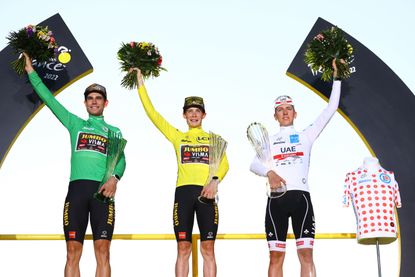
- Yellow jersey
- Green jersey
- Polka dot jersey
- White jersey
- Other classifications

The Tour de France sees the very best cyclists in the world battle it out for the yellow, green, white and polka dot jerseys, based on the general, points, mountains and young rider classifications.
The jersey for each category is awarded to the leader of that classification at the end of every stage, and the recipient earns the right to wear it during the following day's racing. When a rider has the lead in multiple classifications, the yellow jersey is prioritised, then green, the polka dot, and white - the next person on the ranking wears the kit in the leader's stead.
Here we take a brief look at what they are and how they are won.


Tour de France yellow jersey - GC leader
Also called the maillot jaune , the Tour de France yellow jersey is the most coveted piece of kit in professional cycling. The wearer is the rider who has completed the race in the least amount of time, and as such tops the overall or general classification (GC) of the race.
Tadej Pogačar (UAE Team Emirates) dominated the GC in 2020 and 2021, wearing the yellow jersey almost throughout the 2021 edition, before Jonas Vingegaard (Jumbo-Visma) took it off him halfway through the 2022 race, wearing it until the end of the race.
Before that, in 2012, Bradley Wiggins became the first British rider to finish in Paris in the Yellow Jersey - with Chris Froome following up in 2013, 2015-2017. Geraint Thomas took the 2018 race, becoming the third British rider to win the race.
The yellow jersey is sponsored by LCL, a French bank, and it is yellow, because the Tour's original organiser, L'Auto , was a newspaper printed on yellow paper.
Get The Leadout Newsletter
The latest race content, interviews, features, reviews and expert buying guides, direct to your inbox!
A time bonus of 10, six and four seconds will be awarded to the first three riders across the finish line each day (not including TTs). These bonus seconds are taken off their stage and therefore overall time. Bonus seconds of eight, five and two seconds are also awarded on certain, strategically placed climbs on stages one, two, five, 12, 14 and 17.
Last 10 winners of the Tour de France general classification:
- 2013: Chris Froome
- 2014: Vincenzo Nibali
- 2015: Chris Froome
- 2016: Chris Froome
- 2017: Chris Froome
- 2018: Geraint Thomas
- 2019: Egan Bernal
- 2020: Tadej Pogačar
- 2021: Tadej Pogačar
- 2022: Jonas Vinegaard
Tour de France green jersey - points classification
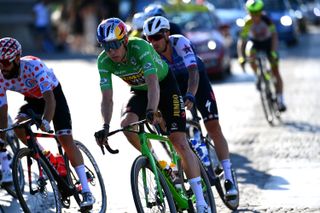
The green jersey relates to points awarded to riders according to the position they finish on each stage, with additional points for intermediate sprints during some stages also on offer.
The number of points on offer will vary depending upon the type of stage. More are on offer during pure flat, sprint days, while on hilly and mountain stages there are fewer points available. The points are then tallied up after each stage and added to points won in all previous stages. The green jersey ( maillot vert) is awarded to the rider with the most points. Sometimes it is a sprinter's game, sometimes more of an all-rounder - like Wout van Aert (Jumbo-Visma).
The jersey took its colour because the initial sponsor was a lawn mower manufacturer - though the colour was changed once in 1968 to accommodate a sponsor. It is now sponsored by Škoda, and has a new shade for this year .
Both Eddy Merckx and Bernard Hinault successfully won both the general classification and the points classification with Merckx achieving the biggest sweep in 1969 with the points, mountain and general classifications to his name. Over the last ten years, Peter Sagan has triumphed in the points classification on no less than seven occasions.
The following points are on offer:
Flat stage (stages 2, 3, 4, 7, 8, 11, 18, 19, 21): 50, 30, 20 points (descending to 15th place)
Hilly stage (stages 1, 9, 10, 12, 13): 30, 25, 22 points (descending to 15th place)
Mountain stage and ITTs (5, 6, 14, 15, 16, 17, 20): 20, 17, 15, (descending to 15th place)
Intermediate sprint: 20, 17, 15, (descending to 15th place)
Last 10 winners of the Tour de France points classification:
- 2013: Peter Sagan
- 2014: Peter Sagan
- 2015: Peter Sagan
- 2016: Peter Sagan
- 2017: Michael Matthews
- 2018: Peter Sagan
- 2019: Peter Sagan
- 2020: Sam Bennett
- 2021: Mark Cavendish
- 2022: Wout van Aert
Tour de France jerseys: Polka dot - King of the Mountains classification leader
Tour de france polka dot jersey - mountains classification.
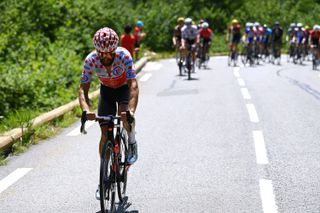
Mountains points are awarded to riders who manage to summit classified climbs first. Points vary depending on the category of each ascent, with more difficult climbs awarding more mountains points.
Climbs are divided into five categories: 1 (most difficult) to 4 (least difficult) - then there's the ' Hors Categorie ', denoted by HC which represents the most challenging of ascents. The tougher the category, the more points on offer, and to more riders - a HC climb will see points awarded down to the first eight over the summit, while a fourth category climb results in points for just the first rider over the top.
The organisers decide which mountains or climbs will be included in the competition, and which category they fall into. If the stage features a summit finish, the points for the climb are doubled.
The points are tallied up after each stage and added to points won in all previous stages. The distinctive white-with-red-dots jersey ( maillot à pois rouges ) is given to the rider with the most mountains points. The first climber's award was given out in 1933, and the jersey arrived on the scene in 1975. It is now sponsored by Leclerc, a supermarket.
Points awarded as follows:
HC: 20, 15, 12, 10, 8, 6, 4, 2pts
1st cat: 10, 8, 6, 7, 5, 1pt
2nd cat: Five, three, two.
3rd cat: Two and one points
4th cat: One point
The souvenir Henri Desgrange is awarded to the first rider over the race’s highest point, the Col de Loze, on stage 17. The souvenir Jacques Goddet to the first rider over the Col du Tourmalet on stage 16.
Last 10 winners of the Tour de France mountains classification:
- 2013: Nairo Quintana
- 2014: Rafał Majka
- 2015: Chris Froome
- 2016: Rafał Majka
- 2017: Warren Barguil
- 2018: Julian Alaphilippe
- 2019: Romain Bardet
Tour de France white jersey - best young rider

The plain white, young rider classification jersey is awarded to the fastest rider born after 1 January 1998, meaning 25 or under. It is sponsored by Krys, an opticians
First introduced in 1975, riders such as Marco Pantani, Alberto Contador, Egan Bernal and Tadej Pogačar have all won the young rider classification, helping propel them onto bigger and better things during their careers.
Last 10 winners of the Tour de France young rider classification:
- 2014: Thibaut Pinot
- 2015: Nairo Quintana
- 2016: Adam Yates
- 2017: Simon Yates
- 2018: Pierre Latour
- 2022: Tadej Pogačar
Other Tour de France classifications - team and combativity
There are two further classifications that do not earn the winner(s) a coloured jersey - the most aggressive rider award and Team Classification .
While not necessarily a classification, the Combativity Award is given to the rider who has shown the most fighting spirit during each individual stage, as chosen by the race jury. They will wear a gold race number during the following day's stage. A 'Super Combativity' award is handed out on the final stage for the most aggressive rider during the whole race.
The Team Classification is based on the collective time of the three highest-placed riders from each squad. Leaders of the team classification get to wear race numbers that are yellow with black digits, and the right to wear yellow helmets. The latter is not compulsory.
Thank you for reading 20 articles this month* Join now for unlimited access
Enjoy your first month for just £1 / $1 / €1
*Read 5 free articles per month without a subscription
Join now for unlimited access
Try first month for just £1 / $1 / €1
Adam is Cycling Weekly ’s news editor – his greatest love is road racing but as long as he is cycling on tarmac, he's happy. Before joining Cycling Weekly he spent two years writing for Procycling, where he interviewed riders and wrote about racing. He's usually out and about on the roads of Bristol and its surrounds. Before cycling took over his professional life, he covered ecclesiastical matters at the world’s largest Anglican newspaper and politics at Business Insider. Don't ask how that is related to cycling.

Get into cycling, get fitter, or ride faster with our cycling training plans
By Anna Marie Abram Published 22 April 24

American gravel and mountain bike brand will "continue to seek a buyer"
By Adam Becket Published 22 April 24
Useful links
- Tour de France
- Giro d'Italia
- Vuelta a España
Buyer's Guides
- Best road bikes
- Best gravel bikes
- Best smart turbo trainers
- Best cycling computers
- Editor's Choice
- Bike Reviews
- Component Reviews
- Clothing Reviews
- Contact Future's experts
- Terms and conditions
- Privacy policy
- Cookies policy
- Advertise with us
Cycling Weekly is part of Future plc, an international media group and leading digital publisher. Visit our corporate site . © Future Publishing Limited Quay House, The Ambury, Bath BA1 1UA. All rights reserved. England and Wales company registration number 2008885.
Here’s Exactly What the Tour de France Jersey Colors Mean
The story behind the yellow, green, polka dot, and white shirts.
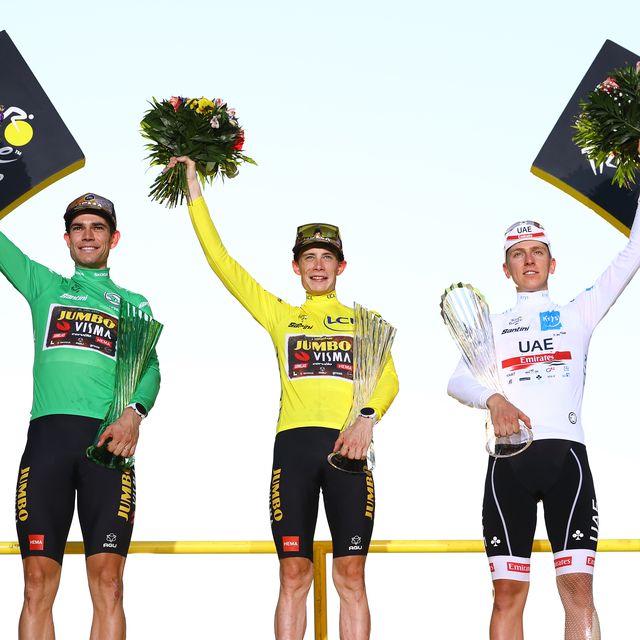
Here’s a simple breakdown of what each Tour de France jersey color means:
Yellow Jersey
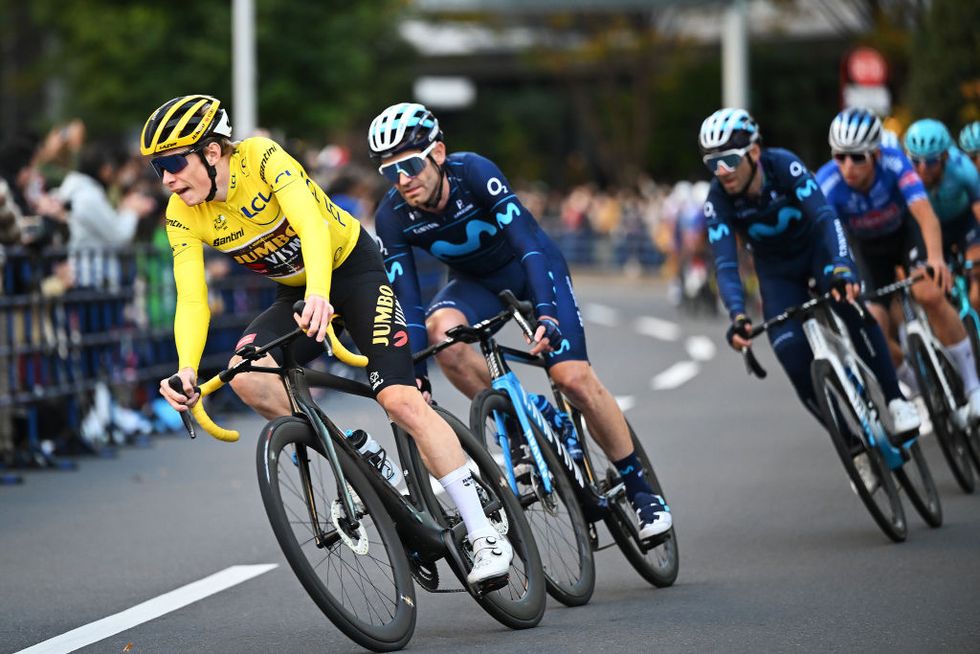
For most, the race’s fabled yellow jersey, or maillot jaune, stands above all else, as it designates the rider who leads the General Classification . After each stage, officials calculate who has the fastest time across the entire race and the jersey then goes to the overall leader. That rider wears it in the following stage. Because it’s based on time and not points, the yellow doesn’t necessarily go to the given day’s stage winner, but rather the leader overall.
Contenders for the yellow jersey—and, therefore, the overall Tour de France title—are well-rounded cyclists and smart tacticians with skills in both climbing and time trialling. They must also show enough strength to hold the pace of the peloton, especially as rival teams work together to drop the leader at every possible opportunity.
Here's how the Tour’s yellow jersey gets made during the race:
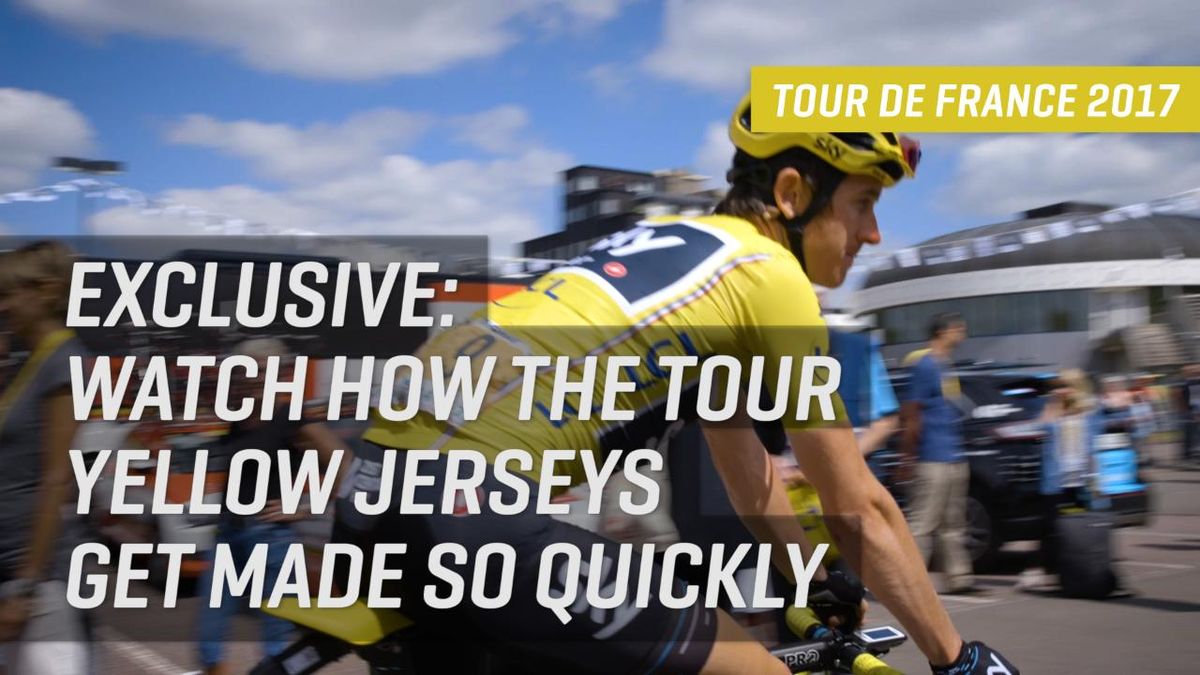
Green Jersey
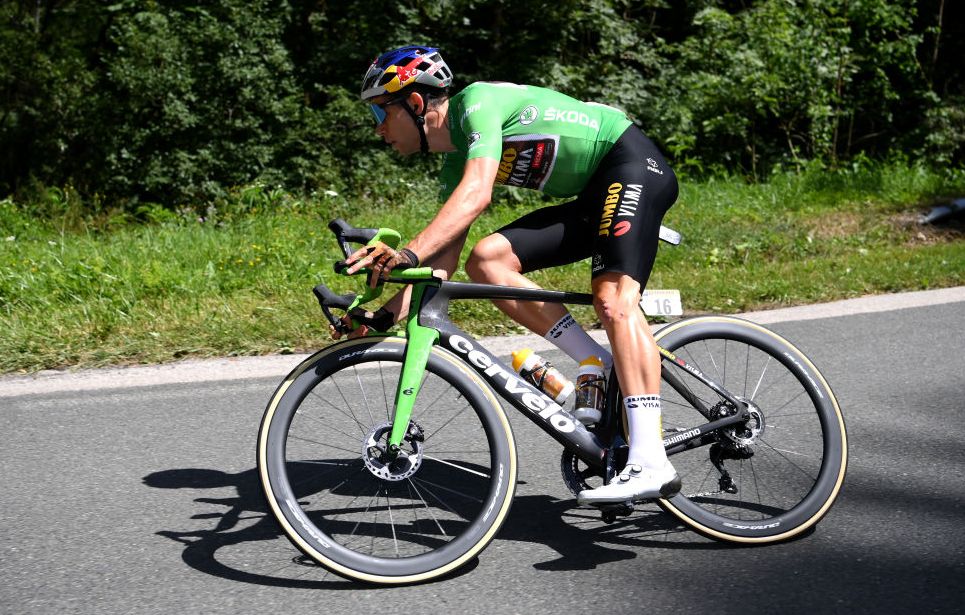
While known as the “sprinter’s jersey,” the green jersey goes to the leader of the Points Classification . The amount of points given depends on the stage profile—whether it’s flat or mountainous, for example. Typically, the winners are the first 10 to 25 riders who cross a stage finish, because the most points are traditionally gained at the end of the flatter stages (where the sprinters shine).
Ultimately, the green goes to a well-rounded and consistent rider, as well as to those who show tremendous persistence, picking up points where they can.
Red Polka Dot Jersey
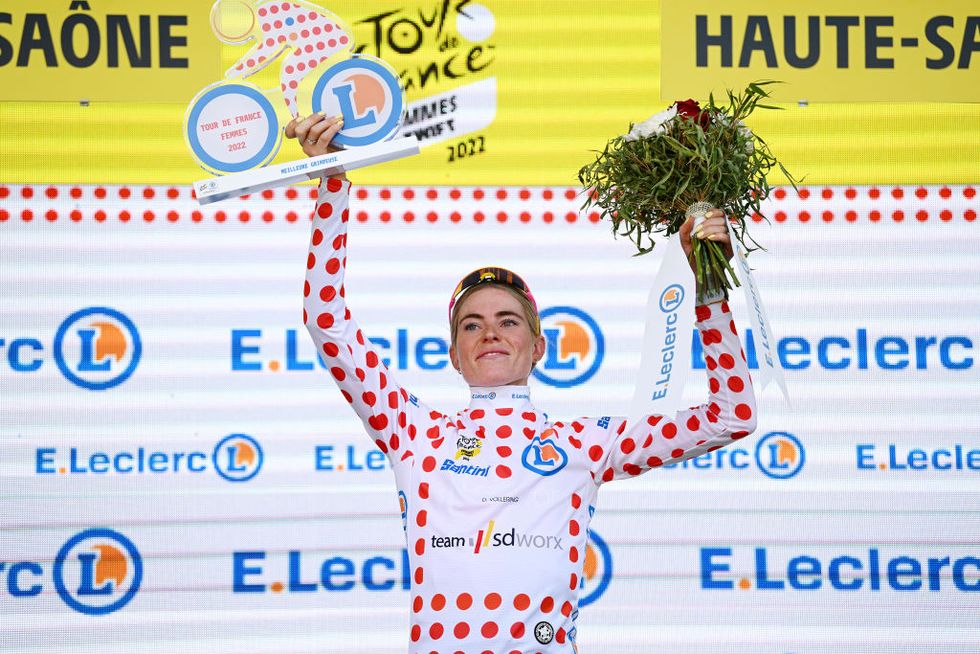
The polka dot jersey goes to the leader of the Mountains Classification , otherwise known as King of the Mountains. Points in this contest are awarded to the first riders who reach the summit of designated climbs on each stage.
Tour de France climbs are ranked from category 1 (most difficult) to category 4 (least difficult). A fifth class, hors catégorie (“beyond category”), is reserved for the most challenging ascents. The amount of points awarded depends on the difficulty of each climb, though sometimes shorter or milder climbs will join a higher category if they come at the end of a stage.
Of course, the rider in polka dots must be a strong climber. Often, it goes to small, lightweight guys with very high power outputs . The KoM competition comes into its own once the race heads into the mountain stages, where most points are available.
White Jersey
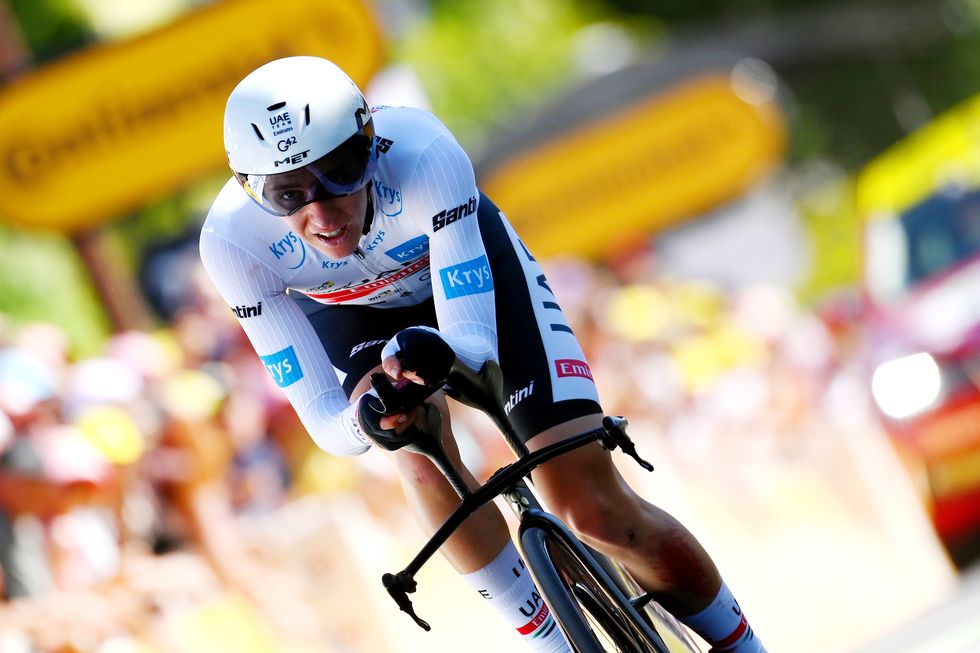
The white jersey, or maillot blanc , goes to the General Classification leader who is 25 years old or younger (on January 1 in the given race year). Put simply, it goes to the best young rider with the lowest overall time. For young, ambitious all-rounders in the race, winning the white jersey is like winning yellow.
Other Awards
Two other classifications exist that are not awarded with a special jersey: the Combativity Award and the Team Classification.
Although largely a token prize, Combativity Award winners still get a podium appearance when the race wraps up in Paris. After every stage, excluding time trials, a panel decides the day’s most aggressive rider. Not necessarily the stage winner, it could be someone who has consistently attacked, instigated a breakaway , or been a key player in the stage outcome. This rider then wears a red race number (instead of black) in the following day’s stage. A Super Combativity Award is given on the final stage for the most aggressive rider throughout the entire Tour.
The Team Classification is based on the collective time of the three highest-placed riders in the General Classification from each team. The best team then wears its race numbers against a yellow background, rather than a conventional white background, and also has the option of wearing yellow helmets.
.css-1t6om3g:before{width:1.75rem;height:1.75rem;margin:0 0.625rem -0.125rem 0;content:'';display:inline-block;-webkit-background-size:1.25rem;background-size:1.25rem;background-color:#F8D811;color:#000;background-repeat:no-repeat;-webkit-background-position:center;background-position:center;}.loaded .css-1t6om3g:before{background-image:url(/_assets/design-tokens/bicycling/static/images/chevron-design-element.c42d609.svg);} 2024 Tour de France Femmes avec Zwift
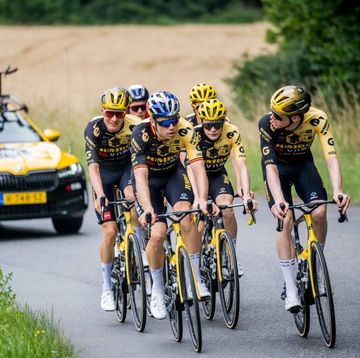
The Fastest Men and Women of the Grand Tours
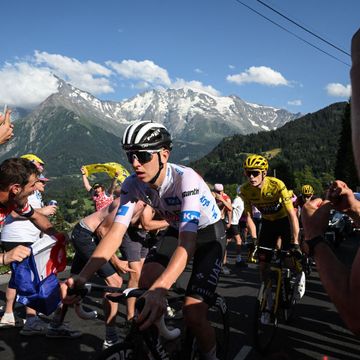
Tour de France 2024 Contender Power Rankings
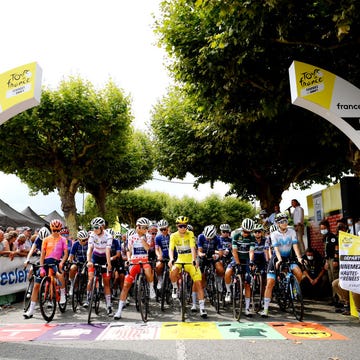
Should We Worry About the Tour de France Femmes?
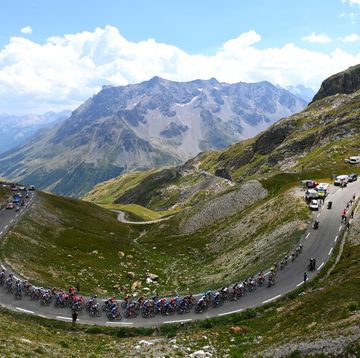
2024 Tour de France May Start Using Drones

Riders Weigh In on the Tour de France Routes

2024 Tour de France/ Tour de France Femmes Routes
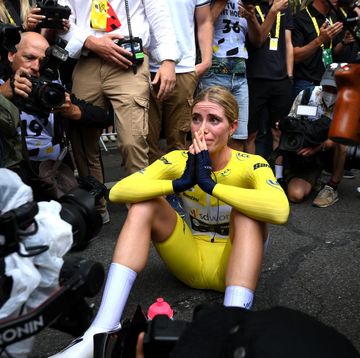
Who Won the 2023 Tour de France Femmes?
Tour de France
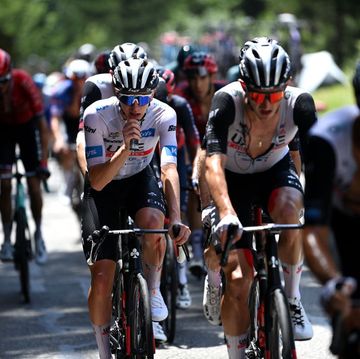
What Do Riders Eat During the Tour de France?

How Fast Do the Pros Ride in the Tour de France?

Challengers of the 2024 Giro d'Italia and TdF
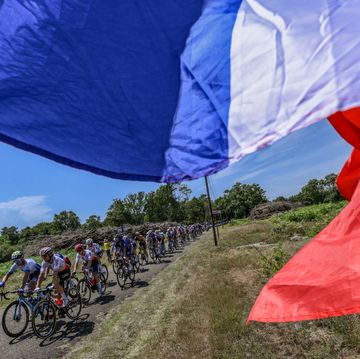
The 2024 Tour de France Can’t Miss Stages
The jerseys of the 2024 Tour de France
Details of the four iconic leader's jerseys and the minor prizes at the race
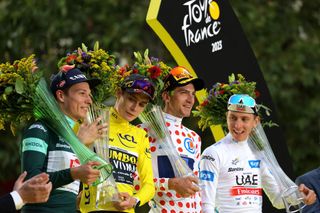
There are four Tour de France classification jerseys awarded after every stage of the three-week race, each recognising different successes and talents in the race.
The iconic yellow jersey is worn by the race leader based on time, the green jersey is awarded to the leader based on points awarded at intermediate sprints and the finishes, the red polka-dot king of the mountains jersey is based on points awarded on categorised climbs, while the white best young rider's jersey is another based on time, only reserved for riders born after January 1, 1998.
The team classification is also based on time, with the riders of the leading team racing with special yellow numbers (dossards). The most aggressive rider wears a special gold number during the following stage.
The most aggressive rider (super-combatif) of the whole race is selected by members of the jury at the end of the Tour de France and is awarded a trophy on the final podium in Paris just like the other competition winners.
Santini is the official jersey maker for the Tour de France, and will put the finishing touches - adding all necessary logos - to the winners' jerseys on-site at the Tour de France. That also means fans can buy their own replica jerseys and other Tour de France merchandising.
The yellow jersey – the maillot jaune

The yellow jersey is worn by the leader of the general classification, the rider with the lowest net time in the race after every stage. The rider who takes it to Paris is crowned the Tour de France winner, the most prestigious success of the men’s cycling season.
Jonas Vingegaard (Jumbo-Visma) won the 2022 and 2023 Tour de France.
Get The Leadout Newsletter
The latest race content, interviews, features, reviews and expert buying guides, direct to your inbox!
The jersey is yellow because the newspaper that first organised the race, L'Auto , was printed on yellow paper.
The classification is based on the time taken for each rider to cover the 21 stages, taking into account time penalties and time bonuses.
In the event of a tie in the general classification, the hundredths of a second recorded by the timekeepers during the individual time trial stages will be included in the total times in order to decide the overall winner.
In the absence of a time trial or if the riders remain tied, then the positions in which they finished each stage will be added up and, as a last resort, their finishing position on the final stage will be taken into account.
Bonus seconds are offered to encourage attacking racing and these are deducted from the time taken to cover the stage. Bonuses of 10, 6, and 4 seconds are awarded on the finish line to the leading three riders on each stage, excluding time trials. There are also certain climbs with bonuses of 8, 5, and 2 seconds at the top such as the Jaizkibel on stage 2 which should encourage aggressive riding from the favourites.
All riders must finish within the time limit – a certain percentage (ranging from 104% to 120% depending on the stage and average speed) of the stage winner's time each day in order to continue in the race. This is often a problem for sprinters, domestiques and injured riders when it comes to the high mountains.
The green jersey – the maillot vert
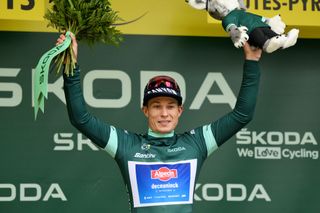
The green jersey is worn by the leader of the points classification. Points are awarded at stage finishes and intermediate sprints.
While the sprinters are the main candidates for the green jersey, it's the more versatile among them who have the best chance of overall success in Paris.
Peter Sagan is one such rider and has won green in seven of the past nine Tours, while Wout Van Aert dominated the points classification in 2022 to take his first green jersey. Jasper Philipsen won four sprint stages to anchor his green jersey in 2023.
Points are awarded to the first 15 riders at stage finishes or intermediate sprints, with different allocations depending on the nature of the stage. More points are awarded on flat stages than on mountain stages or time trials. The winner of a flat stage scores 50 points, a mountain stage winner just 20.
Only riders who complete the entire Tour de France are included in the points classification.
In the event where a rider or riders finish outside the time limit but are reinstated by the president of the commissaires’ jury, they will lose all points awarded to them in the points classification.
For 2023 the green jersey was a much darker shade of green than fans are used to as per a request made by the sponsor of the jersey, Skoda but the colour was not popular with fans.
The polka-dot jersey – the maillot blanc à pois rouges
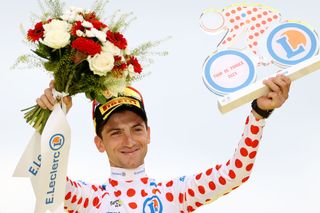
The polka-dot jersey is worn by the leader of the mountains classification, who is known as the 'king of the mountains.’ For the three recent editions of the Tour, the overall winner has also won the polka-dot jersey but Italy's Giulio Ciccone of Lidl-Trek won the competition in 2023.
Mountain points are on offer at the top of every classified climb, ranging from the hardest – 'hors catégorie' – to the easiest – category 4.
Hors catégorie: 20-15-12-10-8-6-4-2
Category 1: 10-8-6-4-2-1
Category 2: 5-3-2-1
Category 3: 2-1
Category 4: 1
In the event of two riders being equal on points, the rider with the most first places at the summit of super-category passes or climbs or summit finishes will be declared the winner.
Only riders who complete the entire Tour de France will be included in the best climber classification. In the event of a rider or riders finishing outside the time limit but being reinstated by the president of the commissaires’ jury, they will lose all points awarded to them in the best climber classification.
The white jersey – the maillot blanc

The white jersey is worn by the leader of the youth classification.
A 'young rider' is anyone who was born after January 1, 1998, so anyone under 25. The jersey goes to the best placed on general classification, based on time.
Tadej Pogačar has won the white jersey at the last four editions of the Tour, two of which he also won the yellow jersey.
The white jersey often used to be an indication of future Tour de France contenders, but since Pogačar has risen to greatness at such a young age, it's been difficult to see the future contenders as obviously. He is now too old for competition, with the white jersey up for grabs in 2024.
The gold dossard
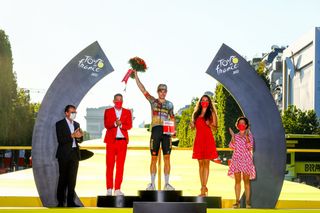
The special gold number dossard is awarded to the rider deemed, subjectively, the ‘most combative’ the previous day. It is usually the rider most active in the breakaway or someone who shows panache and aggression or even qualities of sportsmanship. It used to be a red number, but has changed this year as Century 21 now sponsor the classification and the new colour runs in line with their branding.
The prize, which is awarded on every road stage except the final one, is decided by a jury presided over by the race director and a new vote made by members of the Tour de France Club. Each stage’s most aggressive rider wears a gold race dossard during the following stage.
The race’s most aggressive rider (super-combatif) is selected by members of the jury at the end of the Tour de France and was won by Wout Van Aert in 2022. This year Victor Campenaerts (Lotto Dstny) won the super-combatif award after a number of aggressive attacks on stages.
Yellow dossard

The yellow race number dossard is worn by members of the team leading the teams classification. It is calculated by adding together the times of each team's three best riders on every stage.
Any team reduced to fewer than three riders will be eliminated from the team classification.
Wearing a leader’s jersey is mandatory from the signing-in protocol before the stage start until the post-stage press conference.
Skinsuits are provided to the leaders of the various rankings for time trial stages, with special fitting sessions arranged the day before the time trials.
Riders can lead multiple jersey classifications but only wear one jersey in the race. There is an established order of priority for the different leader’s jerseys: the yellow jersey, followed by the green jersey, then the red polka-dot jersey and finally the white jersey.
When a rider is leading several classifications, they wear the one designated by the order of priority. The other jerseys are then worn by the riders lying second, third or fourth in the corresponding classification.

Stephen is the most experienced member of the Cyclingnews team, having reported on professional cycling since 1994. He has been Head of News at Cyclingnews since 2022, before which he held the position of European editor since 2012 and previously worked for Reuters , Shift Active Media , and CyclingWeekly , among other publications.
Tour de Romandie 2024 start list
I’ve seen the future, and it’s really salty: Testing Flowbio’s new wearable hydration sensor
Lotte Kopecky to skip Tour de France Femmes after Olympics, SD Worx confirm
Most Popular
- MAGAZINE OFFERS
- BIKE INSURANCE
- Best Products
- Maintenance
- Accessories
- Long-Term Reviews
- BikeRadar Podcast
- First Look Friday
- Bike of the Week
- Tech Features
- Routes and Rides
- Bike Galleries
- BikeRadar Bargains
- Buyer's Guides
- Fitness & Training
- Sizing & Fit
- Mountain Biking UK
- Cycling Plus
What do the Tour de France leaders jerseys mean? Yellow, green, polka dot and white jerseys explained
How to win the Tour de France general, sprint, mountains and youth classifications
POOL LEQUIPPE/BELGA MAG/AFP via Getty Images
Colin Henrys
To a first-time viewer, the Tour de France can be a minefield. The winner is not simply decided by which rider crosses the finish line first in Paris.
How can a rider win multiple stages and not wear the yellow jersey? What is that polka dot jersey about? And what's with all the jargon they use?
Here’s our full guide to how the Tour de France is won: the classifications, the jerseys and the previous winners.
Tour de France classifications explained – what do the different jersey colours mean?

The Tour de France consists of four classifications that individual riders can win. The different classifications are signified by coloured cycling jerseys :
- The general classification (GC) – yellow jersey
- Mountains classification – polka dot jersey
- Points classification – green jersey
- Young rider classification – white jersey
The leader of each classification at the end of each stage wears the jersey on the following day.
If they continue to lead, they continue to wear the jersey until someone knocks them from the top of the classification. The leader of the classification at the end of the race is the overall winner of that particular classification.
There is also a team classification, but no coloured jersey is awarded for this.
What is the Tour de France general classification (GC)?

The general classification is the oldest and most coveted classification in the Tour de France, and is led by the rider with the shortest cumulative time.
Each rider’s time is recorded on every stage and the GC ranks the entire field. The leader of the general classification after the final stage in Paris is the overall winner of the Tour de France.
Tour de France yellow jersey explained
The GC comes with the coveted yellow jersey – or maillot jaune in French – which is worn by the leader of the classification until their overall cumulative time is bettered by another rider at the end of a stage.
The yellow jersey then passes on to the new leader of the GC, and so on.
Previous Tour de France winners
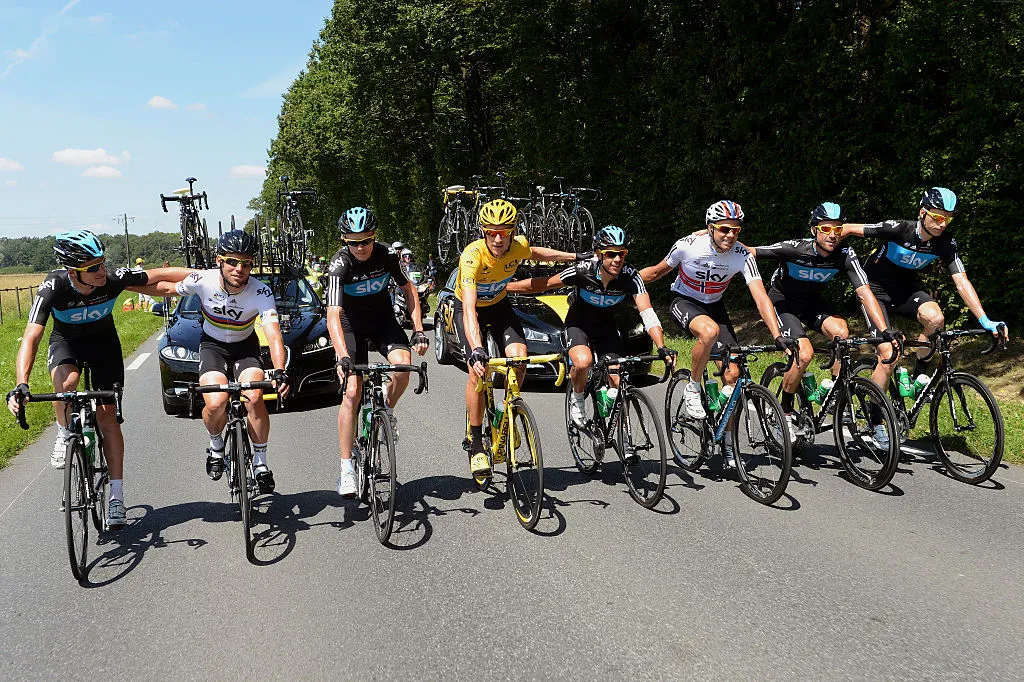
Jonas Vingegaard (Team Jumbo-Visma) won his first Tour de France in 2022, beating Tadej Pogačar (Team UAE Emirates), winner of the previous two editions of the Tour de France.
Egan Bernal's success in 2019 marked Team Ineos-Grenadiers' (formerly Team Sky) seventh Tour de France title in eight years.
Geraint Thomas won in 2018 and Chris Froome claimed four editions before that, after Bradley Wiggins had set the ball rolling in 2012.
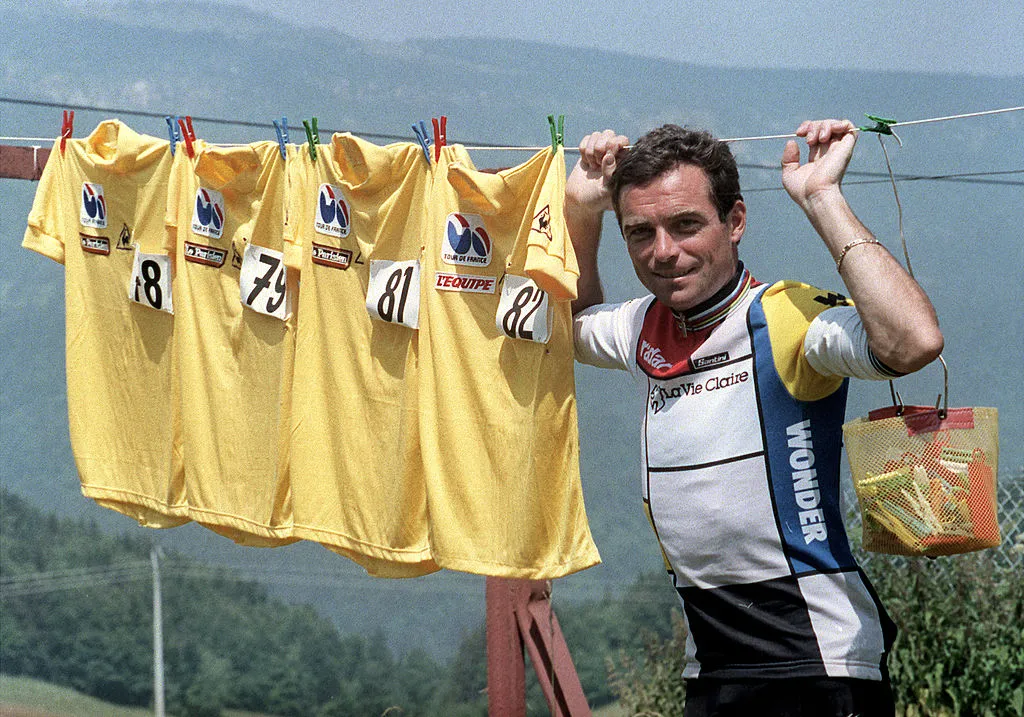
Since the beginning of the Tour, four riders have won the general classification five times: Jacques Anquetil, Eddy Merckx, Bernard Hinault and Miguel Indurain.
Meanwhile, Fabian Cancellara is the rider who has worn the yellow jersey for the most days without ever winning the Tour (29).
Julian Alaphilippe held the jersey for 14 days in 2019, but fell away in the general classification in the final few stages.
Tour de France mountains classification
What is the mountains classification.
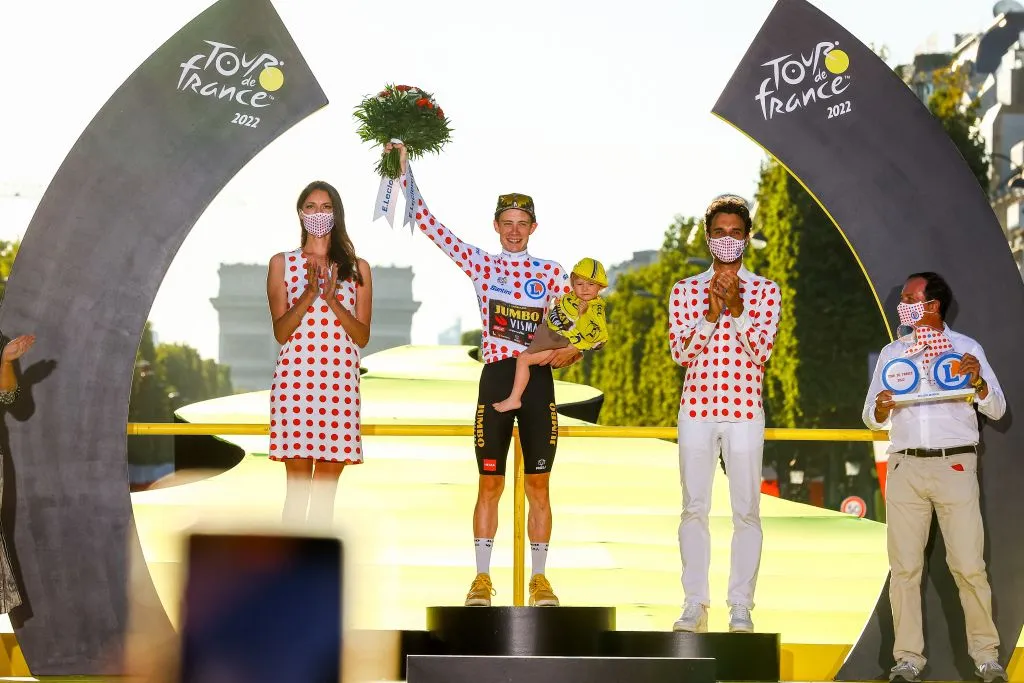
The mountains classification was introduced in 1933 as a secondary competition within the Tour de France.
The first riders to reach the top of categorised climbs in the Tour are awarded a certain number of points according to their position across the summit.
The climbs are categorised by a number, from 1 (difficult) to 4 (least difficult) based on factors such as the climb’s length and gradient.
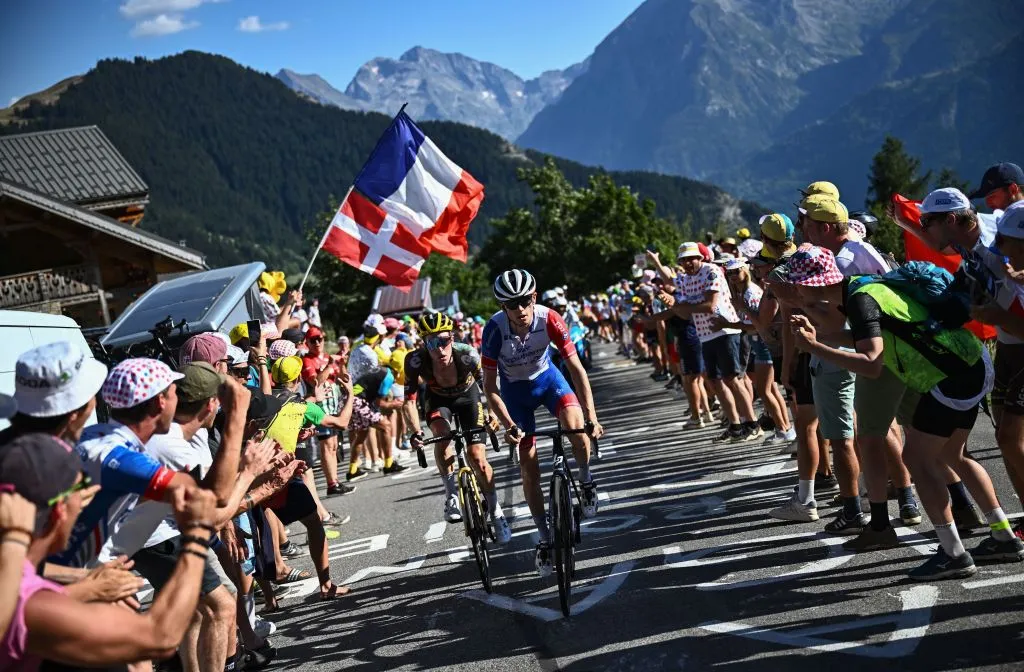
Climbs that are more difficult than category 1 are called h ors catégorie – "a class of their own" in French.
Hors catégorie climbs carry the most points. Summit finishes – stages that finish atop a climb – and category 1 climbs are the next most lucrative followed by category 2 and so on.
The first rider to reach the Col de la Loze, the highest peak of the 2023 Tour de France, on stage 17 will earn double points.
The rider with the highest cumulative points total leads the mountains classification and wears the polka dot jersey. The exception is if they are also leading another classification, such as the general. In that case, the second rider in the rankings wears the jersey.
At the end of the Tour, the overall winner of the classification is the King of the Mountains.
Tour de France polka dot jersey explained
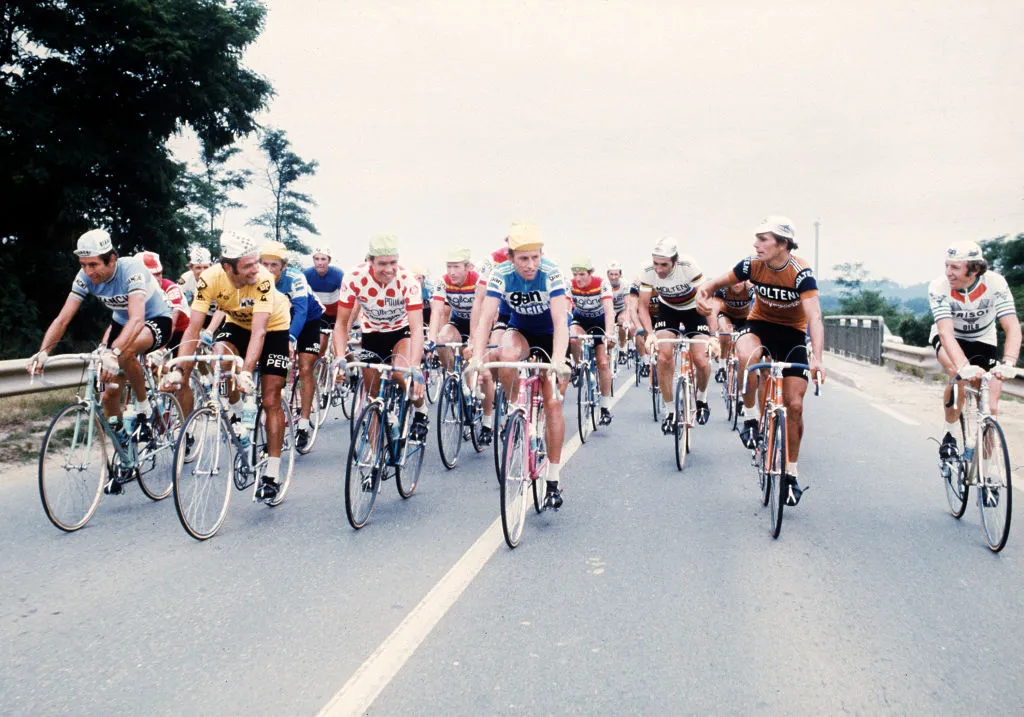
The mountains classification is signified by a white jersey with red polka dots (known as the polka dot jersey or maillot à pois ).
Vicente Trueba was the first winner of the King of the Mountains competition in 1933. The polka dot design wasn't introduced until 1975 when Bernard Thévenet won the classification.
Previous Tour de France mountains classification winners
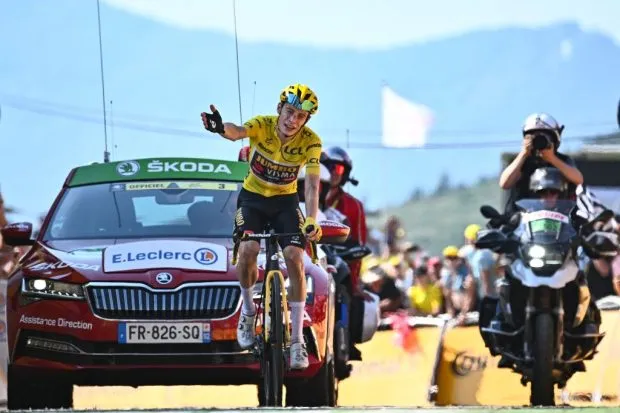
Jonas Vingegaard added the King of the Mountains jersey to his maillot jaune in 2022.
Tadej Pogačar took the mountains classification in 2021 and 2020, following Romain Bardet in 2019 and Julian Alaphilippe in 2018.
Another Frenchman, Richard Virenque, won the title seven times in his career between 1994 and 2004, while both Federico Bahamontes and Lucien Van Impe have won it six times, from 1954 to 1964 and 1971 to 1983 respectively.
Eight cyclists have now won the mountains classification and general classification in the same year:
- Gino Bartali
- Sylvère Maes
- Fausto Coppi
- Federico Bahamontes
- Eddy Merckx
- Carlos Sastre
- Chris Froome
Pogačar, Bartali, Coppi and Merckx have all done it twice.
Tour de France points classification
What is the points classification.
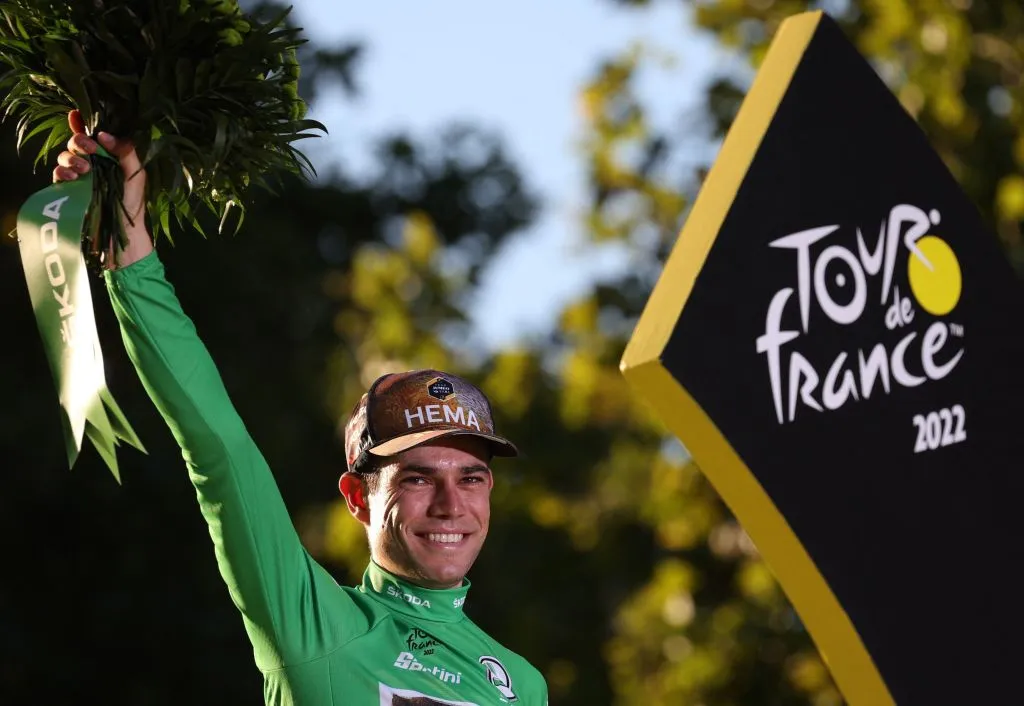
The points classification was introduced in 1953 as an incentive for sprinters, with Fritz Schär being the first rider to win it.
The first 15 riders to complete each stage are awarded points, with the most points going to the first rider and the following 14 receiving successively fewer points.
More points are on offer for flat stages, again as an incentive to the sprinters. Riders can also gain points by winning intermediate sprints (sprints that take place at designated points part-way through a stage).
Tour de France green jersey explained
The leader of the points classification is indicated by a green jersey ( maillot vert ). Green matched the logo of the first jersey sponsor, La Belle Jardinière clothing store.
The overall prize is awarded to the rider with the most points at the end of the Tour.
Previous Tour de France points classification winners
The green jersey went to Wout van Aert in 2022 and Mark Cavendish in 2021.
In previous years the award had become synonymous with one man: Slovakian superstar Peter Sagan. He claimed the prize for a record-breaking seventh time in 2019.
Tour de France young rider classification
What is the young rider classification.
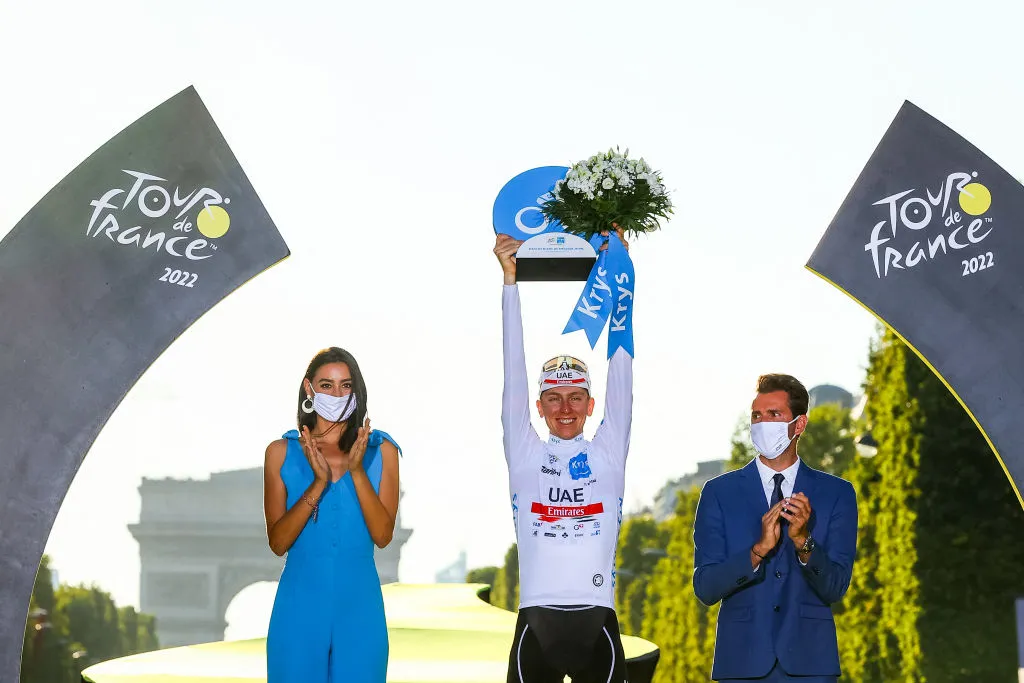
The young rider classification was introduced to the Tour in 1975. Classics great Francesco Moser was its first winner.
This year it applies only to cyclists born on or after January 1, 1998 (under the age of 26).
Just like the general classification, it’s calculated using each rider's cumulative overall time but is aimed at rewarding young riders in the early stages of their careers.
Tour de France white jersey explained
The youth classification is signified by a white jersey, and much in the same way as the other categories, the rider currently topping the classification wears it until someone else overtakes their lead.
Previous Tour de France young rider classification winners

Beaten into second in the GC, Tadej Pogačar was still the fastest young rider in 2022.
The Slovenian had become the sixth man to win both the white and yellow jersey in the same year when he rode to victory at the 2020 Tour de France, joining Egan Bernal (2019), Laurent Fignon (1983), Jan Ullrich (1997), Alberto Contador (2007) and Andy Schleck (2010). He then repeated the feat in 2021.
Pierre Latour won the young rider classification in 2018, while British twins Adam and Simon Yates were triumphant in the previous two years.
What is the Tour de France team classification?
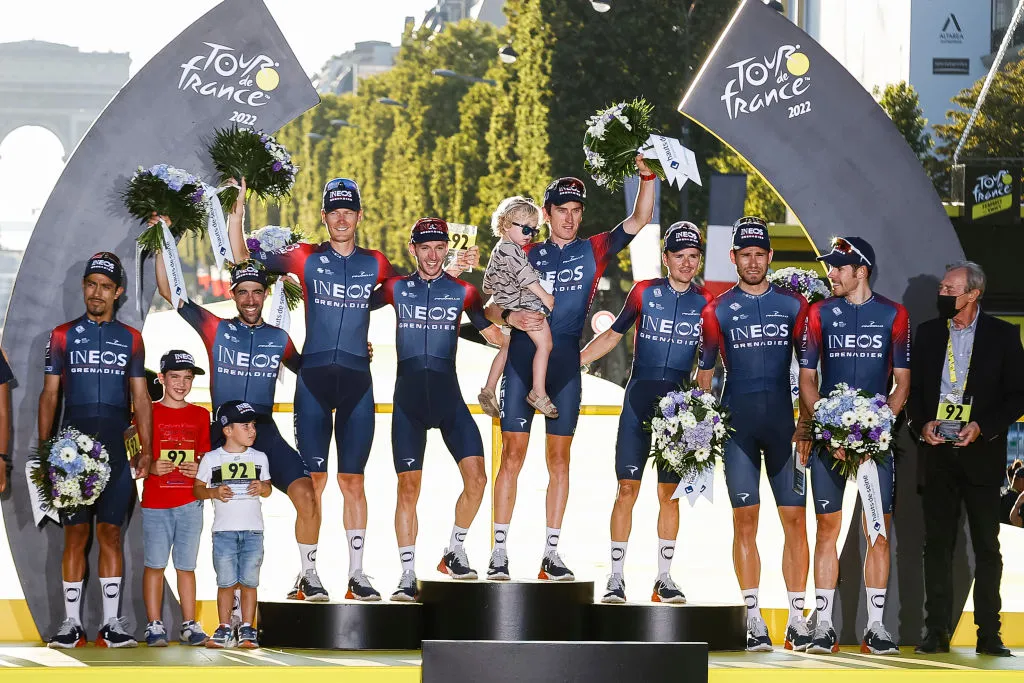
The team classification has been part of the Tour de France since 1930 but awards no coloured jersey. Instead, the team is given race numbers with a yellow background, rather than white.
It’s not considered to be as important as the individual classifications. Teams don’t normally set out with an ambition to win it. But they may change their tactics during the race if they are in a good position to do so.
The team classification takes the time of each squad's top three finishers on every stage. The team with the lowest cumulative time leads the classification.
Previous Tour de France team classification winners
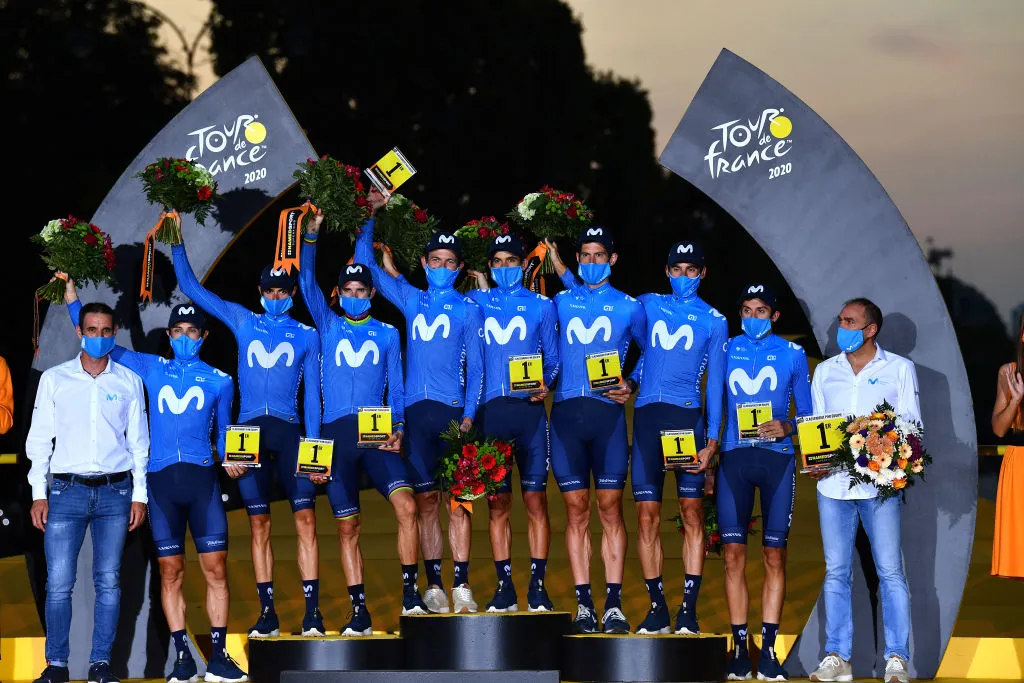
Movistar Team has dominated the classification in recent years, topping the team rankings in 2015, 2016, 2018, 2019 and 2020. This is despite none of its riders winning the Tour in those years.
Generally, the team with the rider leading the Tour will be more inclined to sacrifice teammates to protect the individual's lead, making winning both the individual and team classification – as Team Sky did in 2017 – a rare feat.
Share this article

- Terms & Conditions
- Subscribe to our magazines
- Manage preferences
- Race Previews
- Race Reports
- Race Photos
- Tips & Reviews

Riders to Look Out for at Dwars Door Vlaanderen Men in 2024
Lorena wiebes secures hard-fought victory at gent-wevelgem women’s race, mads pedersen edges out mathieu van der poel in epic gent-wevelgem duel, live: 2024 women’s gent wevelgem, women’s dwars door vlaanderen 2024 race preview.

Email: [email protected]
The Ultimate Guide to the Iconic Jerseys of Tour de France
Mathew Mitchell
- Published on June 29, 2023
- in Men's Cycling
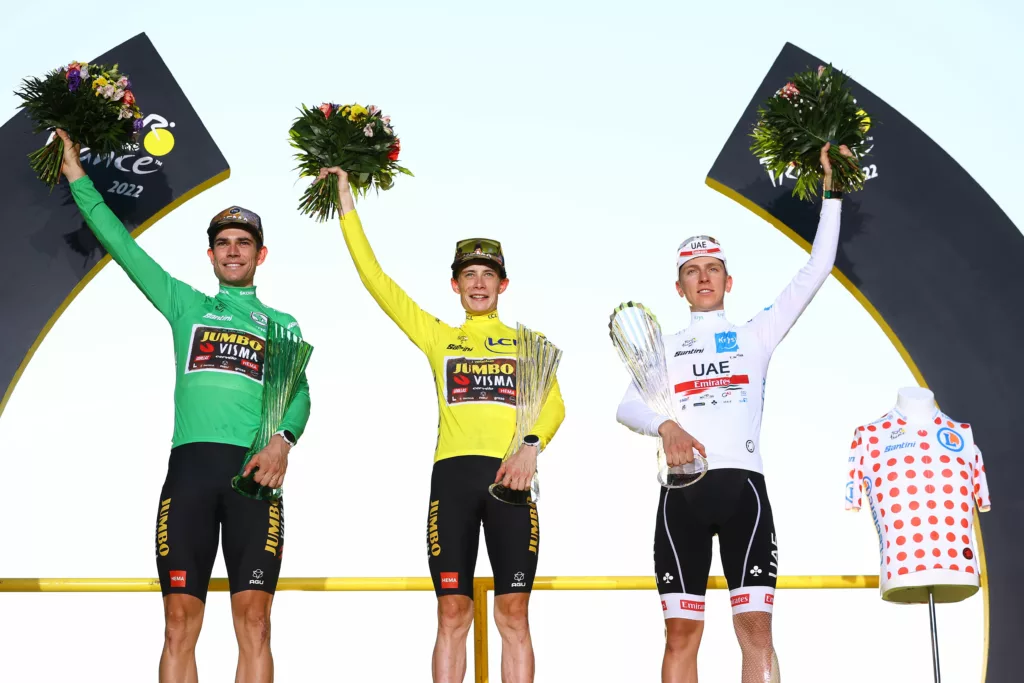
Step into the world of Tour de France and be mesmerised by the kaleidoscope of colours and symbolism that grace the iconic jerseys worn by the pro peloton. In this ultimate guide, we take you on a journey through the rich history and captivating stories behind these renowned garments. From the infamous yellow jersey that symbolises the leader of the race, to the polka dot jersey representing the best climber, each jersey carries its own unique narrative.
Table of Contents
Discover the secrets behind the green jersey, awarded to the best sprinter, and the white jersey, honouring the best young rider. Unveiling the intricate details and design choices, we delve into the significance of every stripe, dot, and patch. Whether you’re a fan of cycling or simply intrigued by the world of sports fashion, this guide will leave you with a newfound appreciation for the artistry and symbolism woven into the fabric of the Tour de France jerseys. So gear up and embark on this captivating journey through the vibrant world of cycling attire.
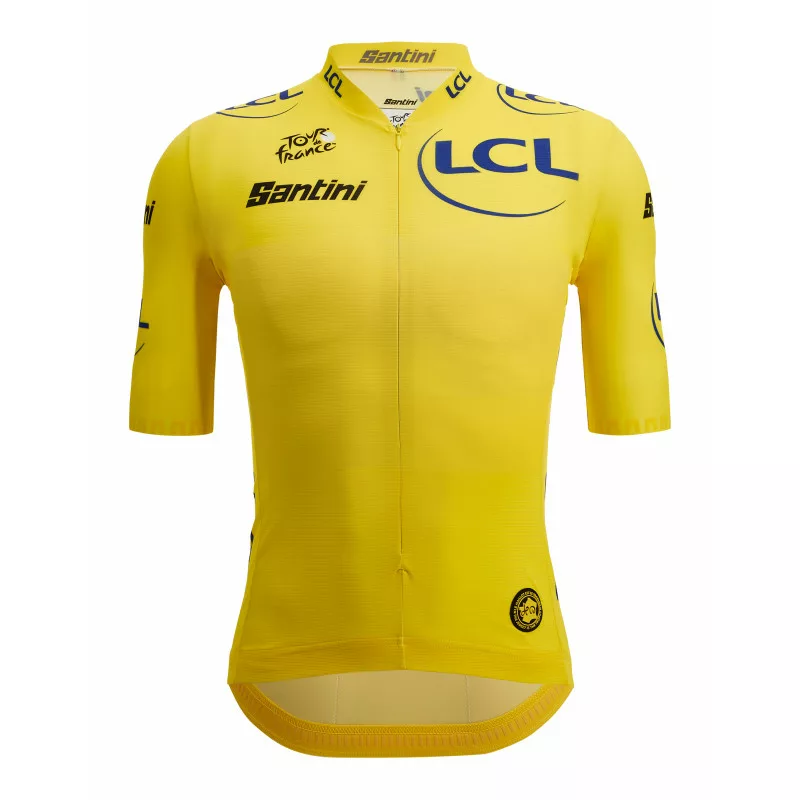
The yellow jersey: Maillot Jaune – The leader’s jersey
The yellow jersey , or Maillot Jaune, is undoubtedly the most iconic and coveted jersey in the Tour de France. Worn by the overall leader of the race, it signifies their dominance and command over the peloton. The history of the yellow jersey dates back to 1919 when it was introduced as a way to easily identify the race leader. The colour yellow was chosen due to its close association with the yellow paper used by the organising newspaper, L’Auto, which later on became L’Équipe.
The yellow jersey is not just a symbol of leadership; it also represents the determination, endurance, and sheer willpower required to succeed in the gruelling race. The jersey’s design has evolved over the years, but its distinctive yellow hue remains a constant. From the classic golden shade to the vibrant lemon yellow, each iteration of the jersey has left an indelible mark on the history of the Tour de France. Similar to the All Blacks in rugby, a simple jersey has come to represent something much bigger.
The yellow jersey is not only a badge of honour but also a target for other competitors. Riders will fight tooth and nail to seize the coveted jersey, resulting in intense battles throughout the race. It is this relentless pursuit of the yellow jersey that adds an extra layer of excitement to the Tour de France, making it one of the most anticipated and thrilling sporting events in the world.
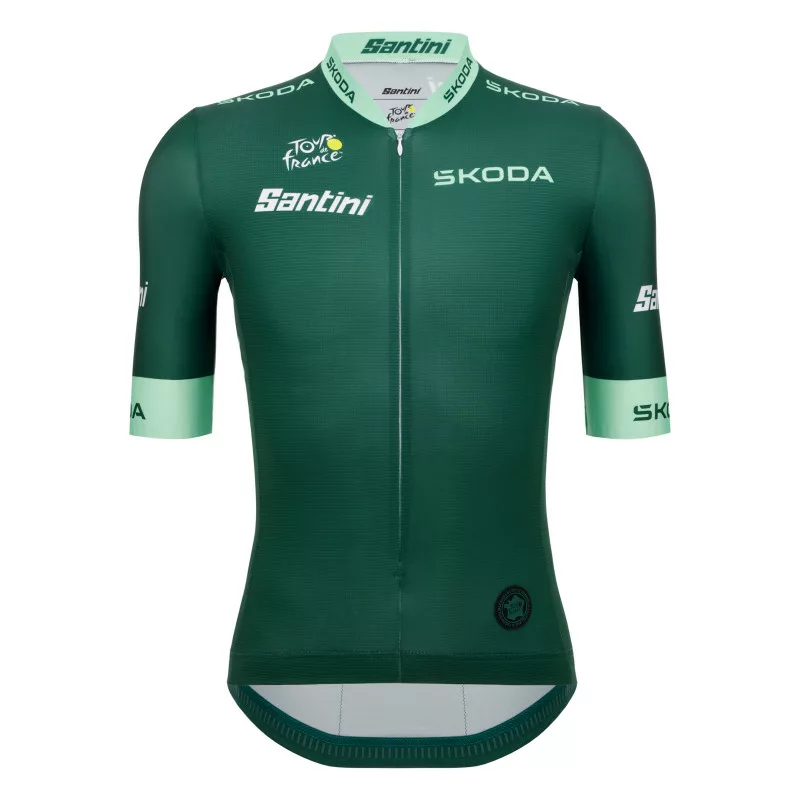
The green jersey: Maillot Vert – The sprinter’s jersey
While the yellow jersey represents the overall leader, the green jersey, or Maillot Vert, is awarded to the best sprinter in the Tour de France. This jersey recognises the riders who excel in the flat stages and possess exceptional speed and strength. It’s not just about flat stages though, increasingly the winner has had to do well on hills. The green jersey was first introduced in 1953 to add another dimension to the race and reward the sprinters for their unique skills.
The green jersey stands out from the crowd with its vibrant shade of green, often referred to as “sprinters’ green.” The colour was chosen to symbolise the lushness and energy associated with sprinting. The design of the jersey features various sponsors’ logos, contributing to its dynamic and eye-catching appearance. Fans of a certain age will remember PMU’s logos on it but for the 2023 Tour de France, Skoda will have their logo on the green jersey.
Winning the green jersey requires consistent performance across the flat stages, where the sprinters have the opportunity to showcase their explosive power. Points are awarded at intermediate sprints and the finish line, with the rider amassing the most points throughout the race being crowned the winner of the green jersey. The battle for the green jersey adds an extra layer of excitement to the Tour de France, as riders push themselves to the limit in thrilling sprint finishes.
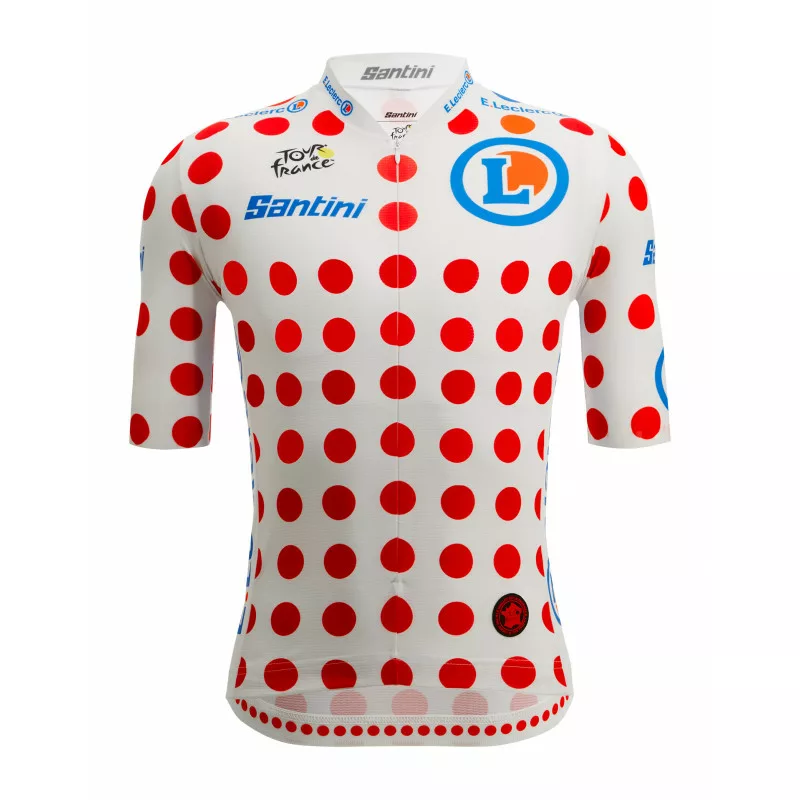
The polka dot jersey: Maillot à Pois – The King of the Mountains jersey
The polka dot jersey, or Maillot à Pois, is one of the most visually striking jerseys in the Tour de France. It is awarded to the rider who excels in the mountain stages, conquering the challenging ascents and demonstrating exceptional climbing abilities. Introduced in 1975, the polka dot jersey adds a touch of drama to the race, highlighting the fierce battles that take place in the mountains. Despite being a relatively recent addition as a jersey, there has been a form of a mountains classification since 1905.
The polka dot jersey gets its name from the distinctive polka dot pattern adorning the jersey. The design was inspired by the red and white polka dot jersey worn by the best climber in the 1969 Vuelta a España, which caught the attention of the Tour de France organisers. The dots represent the mountains and the relentless effort required to conquer them.
To win the polka dot jersey, riders must accumulate points by reaching the mountain summits first. The more challenging the climb, the more points are awarded. The King of the Mountains is determined by the rider with the highest number of points, showcasing their climbing prowess and tenacity. The polka dot jersey has become a symbol of endurance and determination, representing the gruelling battle between man and mountain in the Tour de France.
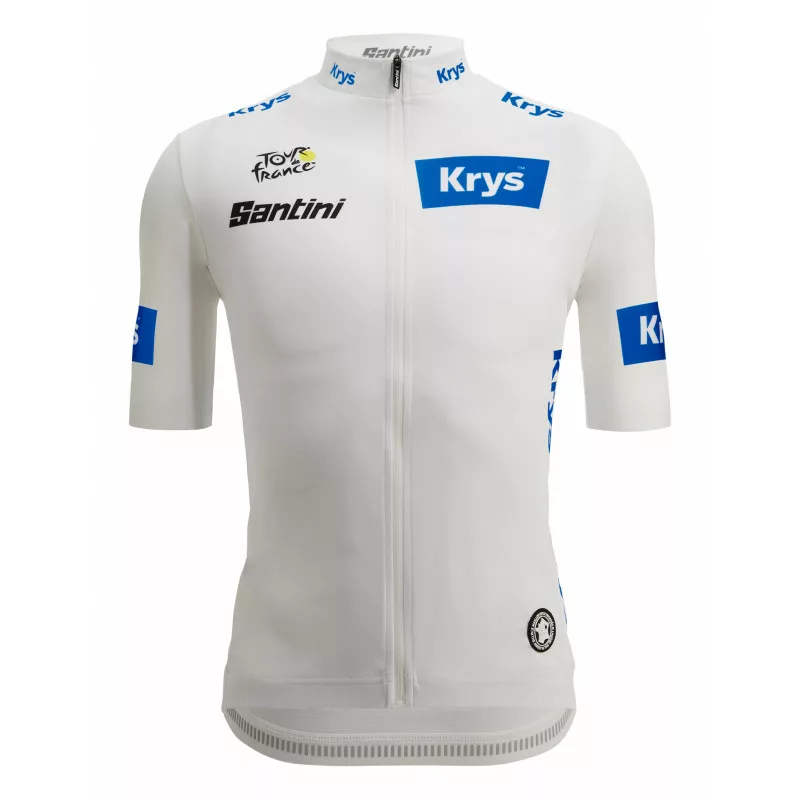
The white jersey: Maillot Blanc – The best young rider jersey
The white jersey, or Maillot Blanc, is a symbol of youthful talent and promise in the Tour de France. It is awarded to the best young rider under the age of 26, highlighting the emerging stars of the sport. The white jersey was also introduced in 1975 to recognise the impressive performances of young riders and provide them with a platform to shine.
The white jersey stands out with its clean and crisp design, representing the purity and potential of young riders. It serves as a reminder that the future of cycling lies in the hands of these talented individuals. The white jersey is often hotly contested, as young riders seize the opportunity to make their mark on the race and showcase their potential.
To win the white jersey, riders must demonstrate exceptional skill and consistency throughout the race. They compete not only against each other but also against more experienced riders, making their achievements even more impressive. The white jersey offers a glimpse into the future of the sport, celebrating the young riders who have the potential to become the next generation of cycling legends.
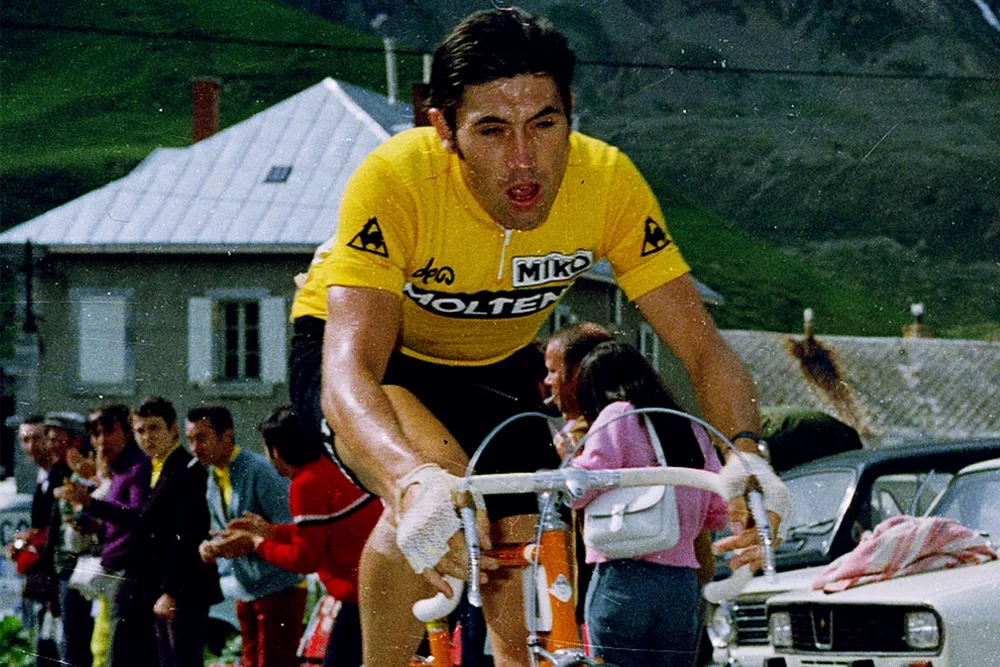
The history and significance of the jerseys
The jerseys of the Tour de France carry a rich history and deep significance that is intertwined with the race itself. Each jersey tells a story, representing different aspects of the sport and the extraordinary athletes who participate in it. From the inaugural yellow jersey that marked the birth of a tradition, to the green jersey that celebrates the explosive power of sprinters, these jerseys have become symbols of excellence and determination.
Over the years, the jerseys have evolved in design and style, reflecting the changing times and the advancements in sports fashion. What started as simple garments to distinguish the race leaders have transformed into works of art, with intricate patterns, bold colours, and sponsor logos adorning the fabric. The design choices are not arbitrary; they are carefully considered to capture the essence of each jersey and its respective category.
The jerseys have also witnessed the triumphs and tribulations of legendary riders who have left an indelible mark on the Tour de France. From Eddy Merckx ‘s dominance in the yellow jersey to Peter Sagan’s reign as the king of the green jersey, these riders have become synonymous with the jerseys they wore, etching their names into the annals of cycling history.
The significance of the jerseys extends beyond the race itself. They have become cultural icons, representing the spirit of competition, the pursuit of excellence, and the camaraderie among riders. Fans and collectors alike treasure these jerseys, displaying them as symbols of their love for the sport and the enduring legacy of the Tour de France.
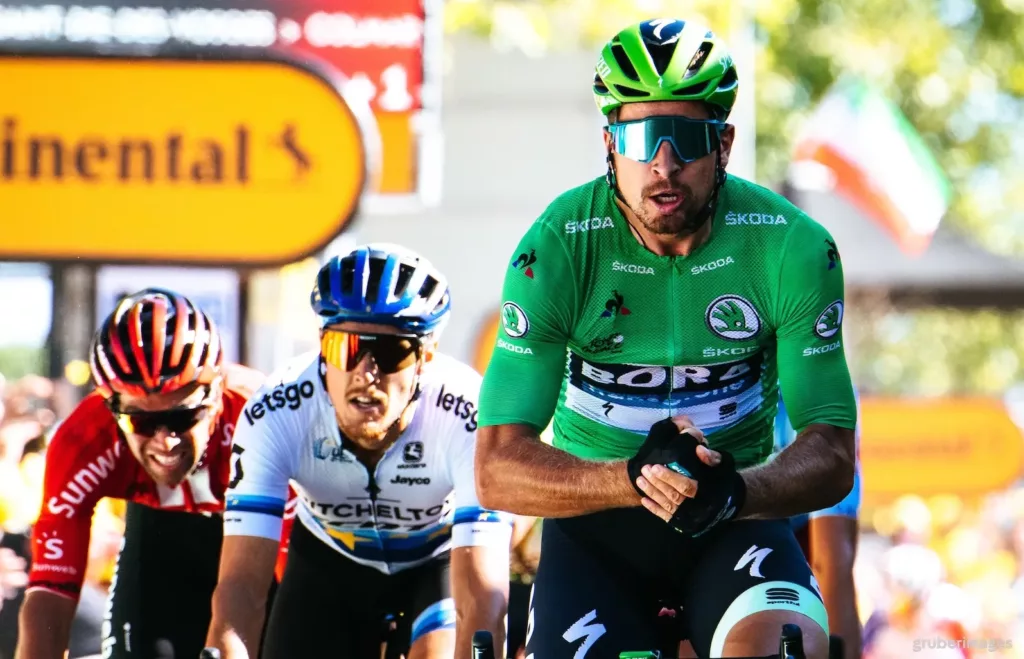
Famous riders who have dominated the jerseys
Throughout the history of the Tour de France, there have been riders who have dominated the different jerseys, leaving an indelible mark on the race. These riders have become legends in their own right, their achievements etched into the fabric of the jerseys they wore.
In the yellow jersey category, one cannot overlook the legendary Eddy Merckx. The Belgian cyclist won the yellow jersey a record-breaking five times and is considered one of the greatest riders in the history of the sport. Merckx’s dominance in the yellow jersey remains unparalleled, earning him the nickname “The Cannibal” for his insatiable hunger for victory.
In the green jersey category, Peter Sagan’s name shines bright. The Slovakian cyclist has won the green jersey a record-breaking seven times, showcasing his exceptional sprinting abilities and versatility as a rider. Sagan’s charismatic personality and thrilling performances have made him a fan favourite, and his reign as the king of the green jersey continues to captivate audiences around the world.
In the polka dot jersey category, Richard Virenque stands out as one of the most successful climbers in the history of the Tour de France. The French cyclist won the polka dot jersey a record-breaking seven times, showcasing his mastery of the mountains and his relentless pursuit of victory. Virenque’s tenacity and climbing prowess have made him a legend among fans of the race.
In the white jersey category, Jan Ullrich’s name holds a special place. The German cyclist won the white jersey three times and went on to become the overall winner of the Tour de France in 1997. Ullrich’s achievements at a young age marked him as a rising star in the sport, and his performances continue to inspire young riders to this day.
These riders, among many others, have left an indelible mark on the Tour de France jerseys, solidifying their status as legends of the race and inspiring future generations of cyclists.
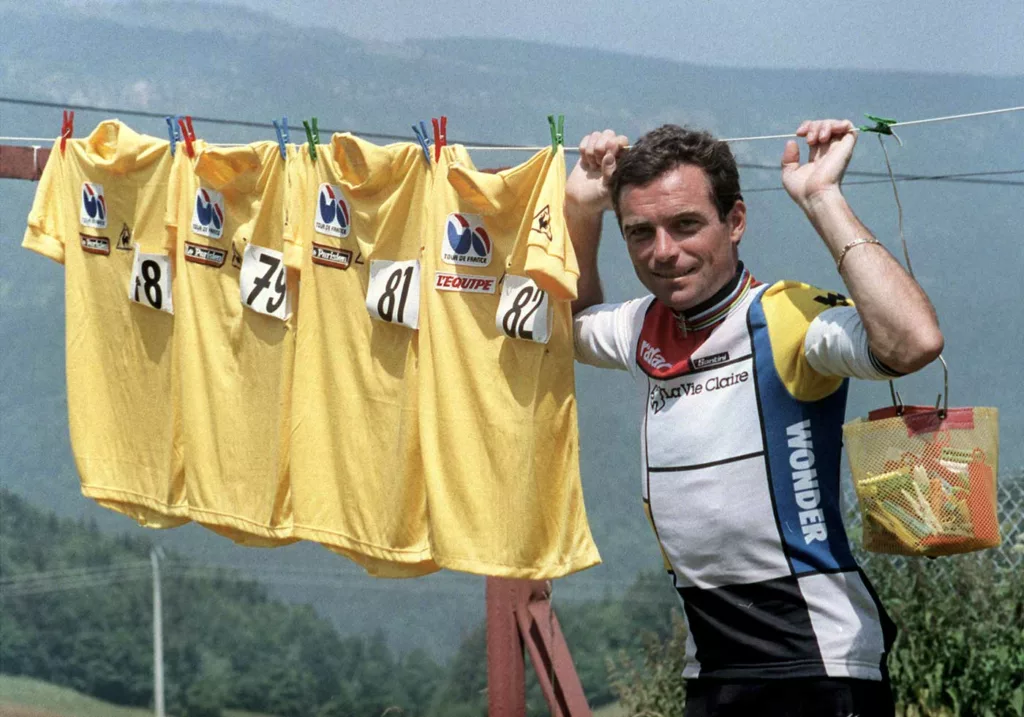
The evolution of the jerseys over the years
The jerseys of the Tour de France have undergone significant changes over the years, reflecting the evolution of both the sport and the fashion industry. What started as simple garments to distinguish the race leaders have transformed into highly sought-after fashion statements, capturing the attention of fans and designers alike.
In the early years of the Tour de France, the jerseys were basic and functional, with minimal design elements. The emphasis was on functionality rather than fashion, as the primary purpose of the jerseys was to identify the race leaders. The yellow jersey, for example, was a simple garment made of wool, featuring a collar, buttons, and short sleeves.
As the race gained popularity and sponsorship deals became more prominent, the jerseys started to incorporate sponsor logos and branding. This marked the beginning of the jerseys’ transformation into advertising billboards, with sponsors’ names and logos becoming prominent features of the design.
In recent years, advancements in fabric technology and printing techniques have allowed for more intricate and visually stunning designs. The jerseys now feature bold colours, intricate patterns, and eye-catching graphics, capturing the attention of fans and creating a sense of excitement around the race.
The evolution of the jerseys is not just limited to their design; the materials used have also undergone significant changes. Wool has been replaced by lightweight synthetic fabrics that offer enhanced breathability and moisture-wicking properties, ensuring that the riders stay cool and comfortable during the race.
The jerseys of the Tour de France are a testament to the ever-changing nature of fashion and the sport itself. They reflect the trends and innovations of their respective eras, serving as a visual timeline of the race’s history and the evolution of cycling attire.
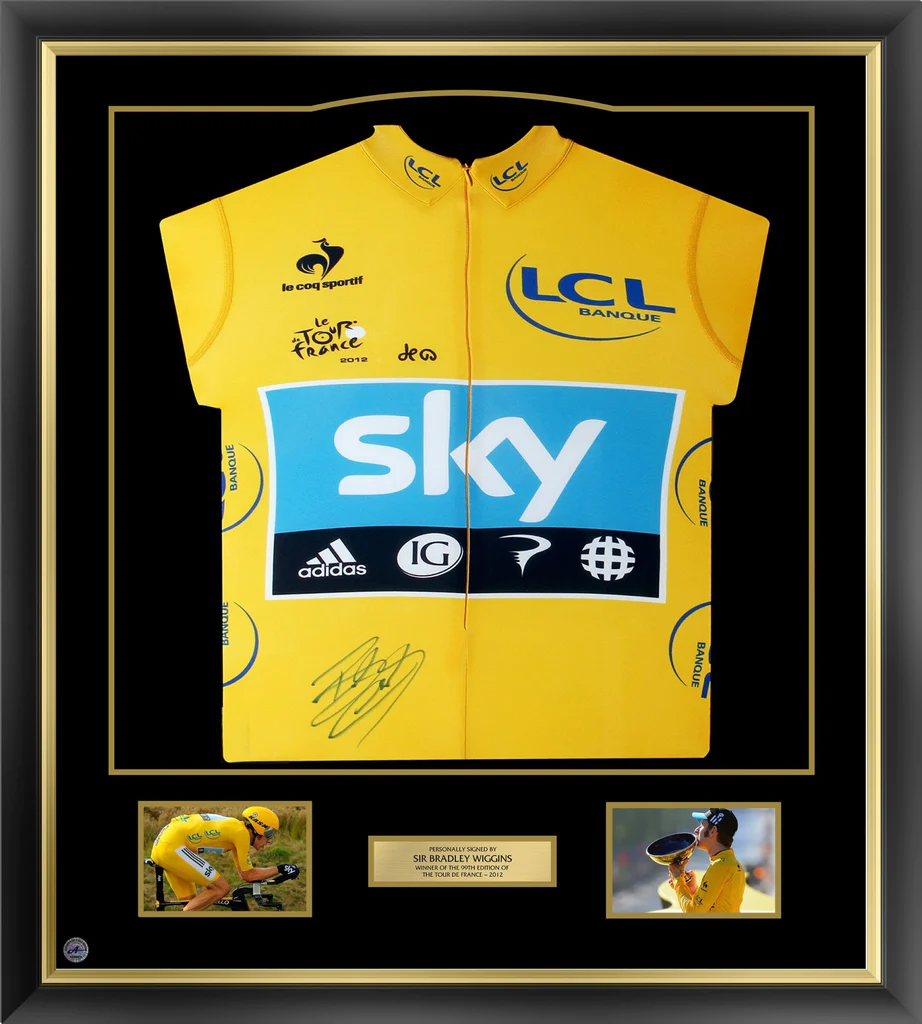
Collecting and displaying Tour de France jerseys
For fans of the Tour de France, collecting and displaying jerseys is a way to celebrate their love for the sport and the iconic race. Tour de France jerseys hold immense sentimental value, representing the history, achievements, and legends of the race. Here are a few tips for collecting and displaying these cherished garments.
Research and authenticity
When collecting Tour de France jerseys, it is important to research their authenticity. Look for official replicas or jerseys that have been verified by reputable sources. Be cautious of counterfeit jerseys that may be circulating in the market.
Focus on significance
Consider collecting jerseys that hold significance to you personally. Whether it’s the yellow jersey of your favourite rider or the polka dot jersey of a legendary climber, choose jerseys that resonate with you and tell a story.
Display with care
When displaying Tour de France jerseys, it is important to handle them with care. Use proper hangers or display cases to prevent creasing or damage to the fabric. Avoid exposing the jerseys to direct sunlight or excessive moisture, as this can cause fading or deterioration.
Tell the story
Accompany your displayed jerseys with information and stories about the riders or the race itself. This adds depth and context to the jerseys, allowing viewers to appreciate their significance and the history they represent.
Rotate your collection
If you have a substantial collection of Tour de France jerseys, consider rotating them periodically to keep the display fresh and interesting. This allows you to showcase different jerseys and riders while preserving the condition of each garment.
Collecting and displaying Tour de France jerseys is not just a hobby; it is a way to pay homage to the sport and the athletes who have made it legendary. It is a celebration of the rich history and captivating stories behind these iconic garments, allowing fans to immerse themselves in the vibrant world of cycling attire.
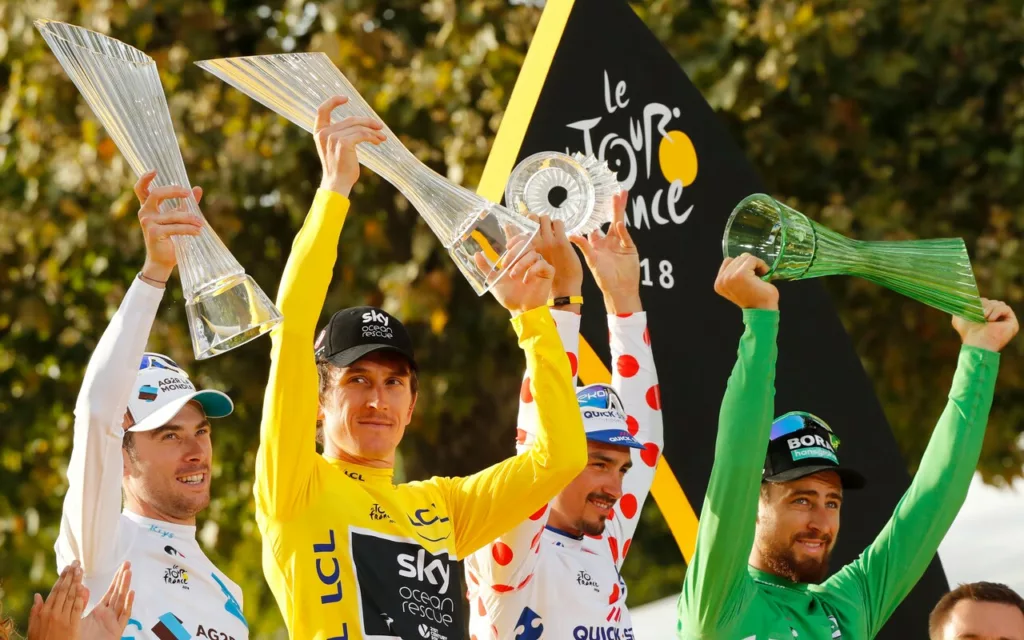
The Tour de France jerseys are more than just pieces of clothing; they are symbols of excellence, determination, and the indomitable spirit of the race. From the iconic yellow jersey that represents the leader to the polka dot jersey that honours the best climber, each jersey carries its own narrative and significance.
The jerseys of the Tour de France have evolved over the years, reflecting the changing times and the advancements in sports fashion. What started as simple garments to distinguish the race leaders have transformed into works of art, with intricate designs and bold colours capturing the attention of fans and designers alike.
Collecting and displaying Tour de France jerseys is a way to celebrate the sport and its legends. These jerseys hold immense sentimental value, representing the history, achievements, and legends of the race. They serve as a visual timeline of the Tour de France’s evolution and the enduring legacy of the athletes who have graced its stages.
So gear up and embark on this captivating journey through the vibrant world of cycling attire. Explore the secrets behind the yellow, green, polka dot, and white jerseys, and discover the stories that have shaped the Tour de France. Immerse yourself in the kaleidoscope of colours and symbolism that grace these iconic jerseys, and gain a newfound appreciation for the artistry woven into the fabric of the race. The Tour de France jerseys are not just garments; they are symbols of triumph, passion, and the enduring spirit of the race.
Related Posts
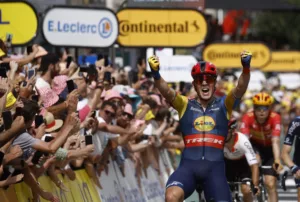

- Associated Press ,

Trending Teams
2023 tour de france jerseys: what do the yellow, green, white and polka dot jerseys mean.
The world’s greatest cyclists have their sights set on the Tour de France 2023 — and with the infamous event less than one month away, not much time remains until we see the best riders compete to obtain the yellow, green, polka-dot and white jerseys. But what do these highly coveted jerseys mean to the cyclists fighting for them?
The famed Tour de France is making its way to NBC and Peacock in just a few weeks, taking place Saturday, July 1 through Sunday, July 23. See below to learn what the Tour de France jerseys mean and how a rider earns one.
RELATED: Tour de France 2023: How to watch, start time, route and more
What is the meaning of the yellow jersey?
Nearly every professional cyclist dreams of someday donning the Tour de France’s yellow jersey, also known as the maillot jaune .
This piece of clothing that stands above all else is awarded to the overall classification leader at the conclusion of each stage, with the fastest rider from the day before given the right to wear the jersey for the following day of racing. It’s important to remember, however, that the winner of this jersey is based on time rather than points, so the winner of the stage is not always the cyclist who gets to bear the yellow jersey.
When the race is completed, the overall champion of the Champs-Élysées receives the fabled yellow jersey. Last year’s winner of the maillot jaune was Team Jumbo-Visma’s Jonas Vingegaard , who remains a favorite for this year’s Tour.
RELATED: Relive Jonas Vingegaard’s 2022 Tour de France victory
What is the meaning of the green jersey?
The green jersey, also known as the maillot vert, is awarded to each day’s leader in points classification. These points are distributed among riders at stage finishes and intermediate sprints in line stages.
The number of points available for each stage varies depending on the stage’s profile. For example, a flat stage finish is typically worth more points than a hilly or mountainous stage finish. The jersey is typically dubbed “the sprinter’s jersey”, and is seen as a symbol of passion and explosivity from the riders who wear it.
Belgian star Wout van Aert earned the maillot vert in fiery fashion last year, picking up 480 points throughout the Tour de France. The closest any rider came to matching this number was Jasper Philipsen , who earned 286.
What is the meaning of the polka-dot jersey?
The Tour de France’s polka-dot covered jersey ( maillot à pois rouges) is awarded to the “King of the Mountains”, the rider who leads the pack in Mountains Classification.
Points are distributed to riders who reach the summit first in designated climbs of each stage. These, points, however, can vary depending on the difficulty of the climb. These climbs are ranked in categories 1 through 4, with 1 being the most difficult and 4 being the least. If a climb is ranked as “ hors catégorie”, it means that this is a climb “beyond category”, reserved for the most challenging endeavors. Points are then awarded based on the category of the climb.
A rider who earns the maillot à pois rouges symbolizes one who pushes beyond their limits with a great deal of courage. In addition to claiming the yellow jersey in 2022, Jonas Vingegaard also claimed last year’s polka-dot jersey, being crowned “King of the Mountains”.
RELATED: Click here for all NBC Sports cycling coverage
What is the meaning of the white jersey?
The white jersey ( maillot blanc) is one of promise and hope for the future. While the jersey first surfaced on the Tour in 1968 to reward the leader of combined classification, its meaning transformed in 1975 to a recognition of cycling’s young achievers.
Today, the white jersey remains as a symbol of youthful talent, being awarded to the best placed cyclist in overall standings under the age of 26. Slovenia’s Tadej Pogacar earned rights to the maillot blanc in last year’s Tour de France at 23 years old.
When is the 2023 Tour de France?
The 2023 Tour de France will take place from July 1-23. The riders will embark on the first stage in Bilbao on Saturday, July 1.
How can I watch the 2023 Tour de France?
Coverage will air on NBC Sports and Peacock from start to finish.
Be sure to follow OlympicTalk for the latest news, storylines, and updates on the 2023 Tour de France!
Site search
- Secret Base
- DraftKings Sportsbook
- DraftKings Daily Fantasy Sports
- DraftKings Network
- Fantasy Football
- Arizona Cardinals
- Atlanta Falcons
- Baltimore Ravens
- Buffalo Bills
- Carolina Panthers
- Chicago Bears
- Cincinnati Bengals
- Cleveland Browns
- Dallas Cowboys
- Denver Broncos
- Detroit Lions
- Green Bay Packers
- Houston Texans
- Indianapolis Colts
- Jacksonville Jaguars
- Kansas City Chiefs
- Las Vegas Raiders
- Los Angeles Rams
- Miami Dolphins
- Minnesota Vikings
- New England Patriots
- New Orleans Saints
- New York Giants
- New York Jets
- Philadelphia Eagles
- Pittsburgh Steelers
- Los Angeles Chargers
- San Francisco 49ers
- Seattle Seahawks
- Tampa Bay Buccaneers
- Tennessee Titans
- Washington Commanders
- Atlanta Hawks
- Boston Celtics
- Brooklyn Nets
- Cleveland Cavaliers
- Dallas Mavericks
- Detroit Pistons
- Golden State Warriors
- Houston Rockets
- Los Angeles Lakers
- Milwaukee Bucks
- Minnesota Timberwolves
- New York Knicks
- Philadelphia 76ers
- Phoenix Suns
- Portland Trail Blazers
- San Antonio Spurs
- Sonics Rising
- Toronto Raptors
- Washington Wizards
- G-League and International
- Bracketology
- Women’s CBB
- Cinderella Stories
- View team list
- Swish Appeal
- Los Angeles Sparks
- Minnesota Lynx
- New York Liberty
- Washington Mystics
- Arizona Diamondbacks
- Atlanta Braves
- Baltimore Orioles
- Boston Red Sox
- Chicago Cubs
- Chicago White Sox
- Cincinnati Reds
- Cleveland Guardians
- Colorado Rockies
- Detroit Tigers
- Houston Astros
- Kansas City Royals
- Los Angeles Angels
- Los Angeles Dodgers
- Miami Marlins
- Milwaukee Brewers
- Minnesota Twins
- New York Mets
- New York Yankees
- Oakland Athletics
- Philadelphia Phillies
- Pittsburgh Pirates
- San Diego Padres
- San Francisco Giants
- Seattle Mariners
- St. Louis Cardinals
- Tampa Bay Rays
- Texas Rangers
- Toronto Blue Jays
- Washington Nationals
- MLB Trade Rumors
- Sabermetrics
- English Premier League
- Aston Villa
- Manchester City
- Tottenham Hotspur
- Leicester City
- Southampton
- Manchester United
- Leeds United
- German Bundesliga
- Bayern Munich
- Italian Serie A
- Inter Milan
- Spanish La Liga
- Atletico Madrid
- Real Madrid
- Women’s Soccer
- Mexican Soccer
- U.S. Soccer
- Fantasy Soccer
- MMA Fighting
- MMA Fighters
- MMA Fight Schedule
Filed under:
- Tour de France
Tour de France jerseys: Colors and meanings explained
The fanciful jerseys that cyclists wear during the Tour de France aren’t simply fashion choices.
Share this story
- Share this on Facebook
- Share this on Twitter
- Share this on Reddit
- Share All sharing options
Share All sharing options for: Tour de France jerseys: Colors and meanings explained
/cdn.vox-cdn.com/uploads/chorus_image/image/60388711/823316740.jpg.0.jpg)
As the Tour de France continues, some riders can be seen sporting jerseys in yellow, green, and white with red polka dots.
No, their jerseys are not a fashion decision. The color of the jerseys actually reflects where a handful of the riders stand in the competition, or their previous success in other races heading into the Tour.
So, what do all the colors of the jerseys mean?
Yellow Jersey:
:no_upscale()/cdn.vox-cdn.com/uploads/chorus_asset/file/11699429/823316700.jpg.jpg)
The yellow jersey is worn by the overall time leader of the Tour de France. This jersey is the most coveted of all the jerseys worn by a rider in the Tour.
The jersey is awarded after each stage of the race. The riders’ total times are added up, and the rider who has completed the stages up to that point in the least amount of time earns the yellow jersey. The overall leader then wears the yellow jersey during the following day of racing, and every day he is still in the lead.
Green Jersey:
:no_upscale()/cdn.vox-cdn.com/uploads/chorus_asset/file/11699497/579354212.jpg.jpg)
The green jersey signifies the leading cyclist in stage points. Riders who finish among the top 15 riders at the end of each stage are awarded points based on position, with first earning the most points.
The number of points awarded for each stage depends on the terrain of the stage. The flatter the stage, the more points awarded to those top positions. As a result, the leaders of the green jersey competition tend to be the best pure sprinters.
There are other opportunities for riders to earn points that contribute to their standing on the points classification. Points are also awarded during the individual time trial stages, and intermediate sprint contests that take place in the midst of traditional stages. These intermediate sprint contests occur at least once during each stage, and are usually worth fewer points than the stage finishes.
Polka Dot Jersey:
:no_upscale()/cdn.vox-cdn.com/uploads/chorus_asset/file/11699531/452385256.jpg.jpg)
The white with red polka dot jersey, also known as the King of the Mountains jersey, is awarded to the cyclist who is the best climber. Points are awarded to the cyclists who top the categorized climbs of the Tour first. The number of points given to the riders depends on the category of the mountain.
The climbs are divided in five categories based on the steepness and length of the climb. An Hors Catégorie climb is literally an “outside category” climb, and is the most difficult type of climb on the Tour. From there, climbs are rated 1-4, with a Category 1 climb being especially difficult, and a Category 4 climb being relatively easy.
The harder the climb, the more points riders can earn at the summit. The points earned from all the climbs of the Tour are added together at the end of each stage, and the jersey is awarded to the rider with the most mountain points.
White Jersey:
:no_upscale()/cdn.vox-cdn.com/uploads/chorus_asset/file/11699541/578324838.jpg.jpg)
The white jersey is awarded to under-25 cyclist who has completed the race in the least amount of time. It is similar to the yellow jersey, but only for this certain age group.
Rainbow Jersey:
:no_upscale()/cdn.vox-cdn.com/uploads/chorus_asset/file/11699563/906921336.jpg.jpg)
The rainbow jersey is not awarded to a rider during the Tour. It can be worn by the reining men’s road race world champion, however — as determined at the UCI Road World Championships during the previous summer — as he competes in the Tour. The world champion in time trials also can wear the rainbow jersey during the time trial stages of the Tour. This year, the individual time trial takes place on Stage 20.
National Champion Jerseys:
:no_upscale()/cdn.vox-cdn.com/uploads/chorus_asset/file/11699577/807799950.jpg.jpg)
Current national road race champions can also choose to wear their national team jerseys during the individual stages.
If a rider wins the yellow, green, polka dot, or white jersey while wearing the rainbow or national team jersey, he can choose which one he wants to race in. During the current Tour, Peter Sagan is both the reining world champion and green jersey leader at the moment, so he’s choosing to wear green as he competes in the Tour.
Other Awards:
:no_upscale()/cdn.vox-cdn.com/uploads/chorus_asset/file/11699565/480771808.jpg.jpg)
There are other awards handed out to certain riders throughout the Tour. The most combative rider — meaning, someone the race jury decides displays a “fighting spirit” during the individual stages — gets to wear a white-on-red number during the following stage.
There is also a team classification, which is based on the times of the top three riders of each team in the overall time standings at the end of every stage. The leading team wears black-on-yellow numbers, and have the option to wear yellow helmets.
Sign up for the newsletter Sign up for the SB Nation Daily Roundup newsletter!
Thanks for signing up.
Check your inbox for a welcome email.
Oops. Something went wrong. Please enter a valid email and try again.
Official games

2023 Edition
- Stage winners
- All the videos
Tour Culture
- Commitments
- key figures
- Sporting Stakes
- "Maillot Jaune" Collection
- The jerseys

FOUR JERSEYS FOR FOUR MEN
For the first time since 2018, the four distinctive jerseys of the Tour de France went to four different riders. Every stage of the 2023 edition shaped the battles that put Jonas Vingegaard in yellow, Tadej Pogačar in white —for the very last time—, Jasper Philipsen in green and Giulio Ciccone in the polka dots. Belgium trounced the other nations in the fight for most stage wins and might have even picked up more if Victor Campenaerts, the most combative rider of the race, had cracked the winning code. Jumbo–Visma won the team classification for the first time in its 40th Tour start under various avatars.
Podium: a duel and brothers in arms
The clash between Jonas Vingegaard and Tadej Pogačar was the main event of the 2023 Tour. Yet it was a different duo that made the headlines early on, as the Yates twins scored a 1-2 in the opening stage in Bilbao, with Adam taking the stage and the yellow jersey. The British rider, who had already pulled on the coveted garment in 2020, savoured a four-day stint in yellow before surrendering the lead to Jai Hindley. Racing in his Tour de France debut, the 2022 Giro champion secured both the stage win in Laruns and the yellow jersey, but he only held it for a day before the start of the Jonas Vingegaard festival. The Dane enjoyed the longest streak in the golden fleece since Bernard Hinault in 1981. The stage to Cauterets also ensconced Tadej Pogačar as the only man who could take the fight to Vingegaard, with a yawning abyss soon opening up between the two stars and the best of the rest. Hindley definitely looked the part of a podium finisher, but a crash in the stage to Morzine loosened his grip on third place. The young Spaniard Carlos Rodríguez surged in the Haute-Savoie resort town to position himself as a podium contender with, perhaps, even loftier ambitions in the future. Promoted to Ineos leader after this flash of talent, he struggled a bit in the Combloux time trial and saw Adam Yates snatch his provisional podium spot. Pogačar's most trusted lieutenant proved to be unshakeable in his defence of third place, but he also pulled off another family exploit in the stage to Le Markstein, where Simon climbed to a career-best overall finish in fourth place. Twins always stick together!
White jersey: a second skin for Pogačar
Tadej Pogačar has been perched at the top of the best young rider's classification since 11 September 2020, when stage 13 of that edition was decided at the top of the Puy Mary. Of course, he was also clad in yellow in his two victorious campaigns in 2020 and 2021, but the white jersey has been his most common outfit in the 84 days he has spent in the Tour so far in his young career. The Slovenian picked up enough time bonuses on the opening day in Bilbao to vault to the top of the category for riders under 25 and never looked back, although his debacle in the stage to Courchevel allowed the 22-year-old Carlos Rodríguez to move within 4′26″. Building on his nigh-unbreakable record of 75 distinctive jerseys worn so far, Pogačar will finally be racing as a grown-up next year!

Green jersey: Philipsen à la belge
In the year marking the 70th anniversary of the green jersey, Jasper Philipsen claimed the points classification the old-fashioned way. In contrast with Peter Sagan, Michael Matthews and Wout van Aert, who have experimented with various methods to win the points classification, such as chasing intermediate sprints, the Alpecin–Deceuninck resorted to a tried-and-tested approach: hoovering up mass sprint victories. Led out by Mathieu van der Poel, he quickly laid down the law in the mad dashes to the line. His triumph in Bayonne was the first of many, as the withdrawals of would-be rivals such as Mark Cavendish, Fabio Jakobsen, Caleb Ewan and Phil Bauhaus cleared his path to glory. Mads Pedersen, who beat him fair and square in Limoges, and to a lesser extent Bryan Coquard did what they could, but the fastest man of the 2023 edition was in a league of his own. Indeed, only Victor Lafay managed to steal his thunder for a short time on the road to Bayonne, allowing the Frenchman to wear the green jersey for two days. When all was said and done, "Jasper the Master" wrapped up the 21st Belgian victory in the points classification with 119 points to his name.
Polka-dot jersey: a job for a professional
Neilson Powless, a credible contender for the polka-dot jersey, had his time in the sun in the first two thirds of the Tour, building his lead on up small hauls of points on minor climbs. The American calculated his energy expenditure to wear the best climber's jersey for 12 stages, with a one-day hiatus in which Felix Gall pulled ahead by a hair's width. However, it all became a lost cause when Giulio Ciccone finally took the gloves off. The Lidl–Trek rider, who had already conquered the mountains classification in the 2019 Giro and this year's Critérium du Dauphiné, had more staying power on long ascents. He started to tip the scales in the stage to Morzine, followed by solid performances in Saint-Gervais and at Courchevel, where he came up short in the battle for the stage win with Felix Gall. The young Austrian climber and Jonas Vingegaard spelled double trouble for Ciccone in the closing stages of the race, but he sealed the deal in the stage to Le Markstein, taking top points on the Col de la Schlucht to become the first Italian winner of the polka-dot jersey since Claudio Chiappucci scored a brace in 1991 and 1992.

Stages: the Spanish Reconquista
Jasper Philipsen's dominance in the sprints did the heavy lifting for Belgium's comfortable win on the medal table, with his young countryman Jordi Meeus adding a touch of prestige with his victory on the Champs-Élysées. However, with a total of 17 different stage winners, the 2023 honour roll looks like a miniature United Nations, including a new taste of glory for Canada (with Michael Woods on the Puy de Dôme), Austria (courtesy of Felix Gall at Courchevel) and Poland (thanks to Michał Kwiatkowski on the Grand Colombier).
Behind Belgium, there were three countries with three stage wins to their names: Slovenia, with Tadej Pogačar and Matej Mohorič, no strangers to success; Denmark, with Kasper Asgreen, who clinched his maiden win, as well as Jonas Vingegaard and Mads Pedersen; and Spain, which was expected to shine as early as the first few stages in the Basque Country but hit the jackpot a bit later. Pello Bilbao claimed his first Tour win in Issoire to end a 99-stage drought for the country of Contador and Indurain. Ion Izagirre kept it up with a triumph in Belleville-en-Beaujolais, shortly before Carlos Rodríguez laid down a marker for the future in Morzine. The rise of the young Andalusian talent makes it seem unlikely that Spain will have to wait another 99 stages for its next win.
Meanwhile, on the home front, Victor Lafay's tour de force in San Sebastián put a smile back on the faces of the Cofidis clan after 15 years in the desert, but the hype around David Gaudu's podium prospects came to naught, while Romain Bardet crashed out of the Tour in stage 14. David Gaudu, Guillaume Martin and Thibaut Pinot clustered together in ninth, tenth and eleventh place overall. As a consolation prize, the Groupama–FDJ rider, who will be retiring at the end of the season, won over the hearts of spectators and TV viewers in France and beyond with his solo adventure in the stage to Le Markstein. They say the French tend to romanticise honourable defeats… and "Tibopino" will always be a fan favourite!

Teams: the black and yellow swarm
Shining in yellow at the top of the Tour de France hierarchy, there can only be one man, and that man has been Jonas Vingegaard for two years. But the conquests of the young Dane have illustrated the increasingly significant importance of the cycling collective, with a Jumbo-Visma team full of versatile and complementary talents to launch the leader to glory. Tiesj Benoot, Wilco Kelderman, Sepp Kuss, Christophe Laporte, Wout van Aert, Dylan van Baarle and Nathan Van Hooydonck: Vingegaard was accompanied by an impressive swarm of bees whose ferocity on all terrains also leaves its mark in the records. Supporting their leader from the Grand Départ in Bilbao, the Jumbo-Visma arrived in Paris as winners of the team classification, for the first time in the history of the Dutch squad. Richard Plugge's men finished ahead of UAE Team Emirates and Bahrain Victorious to succeed the Ineos Grenadiers.
Combativity: Super Campi!
So many battles on the Basque, Navarrese and French roads during the three weeks of the Tour! The intensity rarely dropped and it took loads of determination as well as power and endurance to stand out among the countless attacks that gave life to the race. In this field, Victor Campenaerts is an outstanding leader. The former time trial specialist, who held the hour record from 2019 to 2022, now uses his talents for long range attacks, on the plain as well as in the mountains. And he seems to never tire! With more than 600 kilometres at the forefront, the “Super combatif” of the Tour 2023 won the Century 21 Prize for combativity in two consecutive stages (18 and 19), like Wout van Aert at the start of the event (5 and 6), an unprecedented performance since… Peter Sagan in 2015. It was more than necessary to resist the Thibaut Pinot mania.
Best teammates: Van Aert, Kuss and Skjelmose honored
The role of “domestique” is not ungrateful and the best teammates of the Tour have shown that it calls for a prize dedicated to these riders who selflessly ride as strong as possible for their companions. From the first week, Wout van Aert showed the full extent of his talents, especially when he accompanied Jonas Vingegaard’s first attacks in the Pyrenees. The jury and the public named the Belgian all rounder the winner of the first prize for best team member sponsored by the Hauts-de-Seine department. It was then the American super climber Sepp Kuss who took over to support the Maillot Jaune in the Jura and the approach to the Alps. Finally, Mattias Skjelmose fought on all terrains to support his leaders Mads Pedersen and Giulio Ciccone. The young Dane is a leader in the making... But his work as a teammate already makes him a champion.

You may also enjoy

Tourtel Twist to continue to add zest to the Tour de France

Predict the winner of Liège-Bastogne-Liège

Predict the winner of La Flèche Wallonne 2024!
Receive exclusive news about the Tour

Accreditations
Privacy policy, your gdpr rights.

IMAGES
COMMENTS
The Tour de France sees the very best cyclists in the world battle it out for the yellow, green, white and polka dot jerseys, based on the general, points, mountains and young rider ...
The Jerseys - Tour de France. Santini goes yellow: the Tour de France to wear made in Italy. Santini Cycling Wear and A.S.O. are delighted to announce a new agreement making the Italian brand official partner to the Tour de France from 2022 to supply the prestigious Yellow Jersey and the other official jerseys for the elite multi-stage road race.
The symbol of the Tour de France, the yellow jersey, sponsored by LCL, is worn every day by the leader of the general individual classification and bestowed on the overall winner on the Champs-Élysées.A symbol of excellence, prestige and victory, the yellow jersey is beyond the reach of all but the most well-rounded riders —those who can hold their own on the plains, in the mountains and ...
Here's Exactly What the Tour de France Jersey Colors Mean. The story behind the yellow, green, polka dot, and white shirts. Watching the Tour de France can look psychedelic—so many colorful ...
Official Tour de France merchandise and gear is at Le Tour De France Official Online Store UK. Shop Tour de France jerseys, shirts and Tour de France clothing to watch the prestigious race in style.
Shop Tour de France men's apparel and clothing at Le Tour De France Official Online Store ROW. Guys, gear up with Tour de France men's jerseys, shirts and clothing from Le Tour De France Official Online Store ROW today. ... Tour de France 2023 Replica Team Jersey by Santini - Yellow. US$30.00 US$ 30 00. Tour de France Leader T-Shirt - Black. US ...
Tour de France 2022 Authentic Team Jersey by Santini - Green. US$13700.
Santini is the official jersey maker for the Tour de France, and will put the finishing touches - adding all necessary logos - to the winners' jerseys on-site at the Tour de France. That also ...
Tour de France Femme 2023 Authentic Team Jersey by Santini - Green. US$13900.
At the Le Tour de France Store, we take pride in offering an extensive selection of high-quality cycling merchandise. Discover a wide range of products, including Le Tour de France shirts, jerseys, shorts, gloves, helmets, and shoes, all designed to provide comfort and performance during your rides. We also feature an exclusive collection of Le ...
What do the yellow, green, polka dot and white jerseys mean at the Tour de France? And who are the previous winners?
Shop Tour de France men's apparel and clothing at Le Tour De France Official Online Store EU. Guys, gear up with Tour de France men's jerseys, shirts and clothing from Le Tour De France Official Online Store EU today. ... Tour de France 2023 Replica Team Jersey by Santini - Yellow. US$37.00 US$ 37 00. Tour de France Cycling Cap Graphic T-Shirt ...
The yellow jersey, or Maillot Jaune, is undoubtedly the most iconic and coveted jersey in the Tour de France. Worn by the overall leader of the race, it signifies their dominance and command over the peloton. The history of the yellow jersey dates back to 1919 when it was introduced as a way to easily identify the race leader.
Symbol of the mountains, of a rider pushing beyond their limits and of courage, the red polka dot jersey, which is sponsored by E.Leclerc, is awarded to the Tour de France's leader of the best climber classification.Although this classification was introduced in 1933, its symbol, the polka dot jersey, appeared in 1975, which was also the year the Tour first finished on the Champs-Élysées ...
Created in 1953 on the occasion of the Tour de France's 50th anniversary, the green jersey, which is sponsored by Skoda, rewards the rider who is leading the points classification each day. Points are awarded at stage finishes and at the intermediate sprints in line stages. It owes its colour to its first partner, La Belle Jardinière, a ...
Today, the white jersey remains as a symbol of youthful talent, being awarded to the best placed cyclist in overall standings under the age of 26. Slovenia's Tadej Pogacar earned rights to the maillot blanc in last year's Tour de France at 23 years old. When is the 2023 Tour de France? The 2023 Tour de France will take place from July 1-23.
Shop Tour de France men's apparel and clothing at Le Tour De France Official Online Store UK. Guys, gear up with Tour de France men's jerseys, shirts and clothing from Le Tour De France Official Online Store UK today. ... Tour de France 2023 Replica Team Jersey by Santini - Yellow. US$35.00 US$ 35 00. Tour de France Cycling Cap Graphic T-Shirt ...
The yellow jersey is worn by the overall time leader of the Tour de France. This jersey is the most coveted of all the jerseys worn by a rider in the Tour. The jersey is awarded after each stage ...
Official Tour de France merchandise and gear is at Le Tour De France Official Online Store ROW. Shop Tour de France jerseys, shirts and Tour de France clothing to watch the prestigious race in style.
WHITE JERSEY. Although the white jersey first appeared in 1968 to reward the leader of the combined classification, which was based on the overall, points and mountains standings, it wasn't until 1975 that it began to symbolise the future and youth of the Tour de France peloton. A leader in waiting, the wearer of the white jersey, which is ...
FOUR JERSEYS FOR FOUR MEN. For the first time since 2018, the four distinctive jerseys of the Tour de France went to four different riders. Every stage of the 2023 edition shaped the battles that put Jonas Vingegaard in yellow, Tadej Pogačar in white —for the very last time—, Jasper Philipsen in green and Giulio Ciccone in the polka dots.